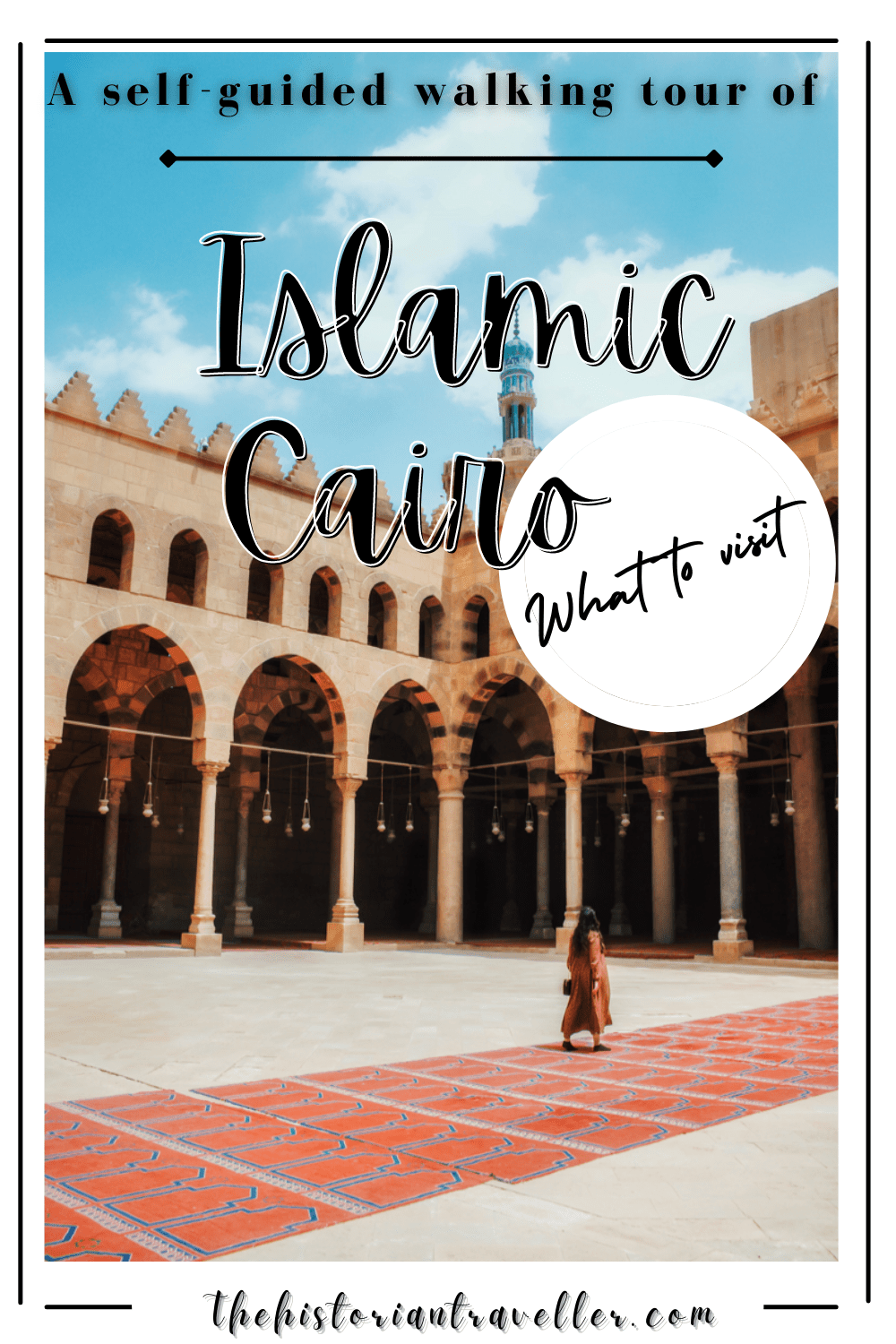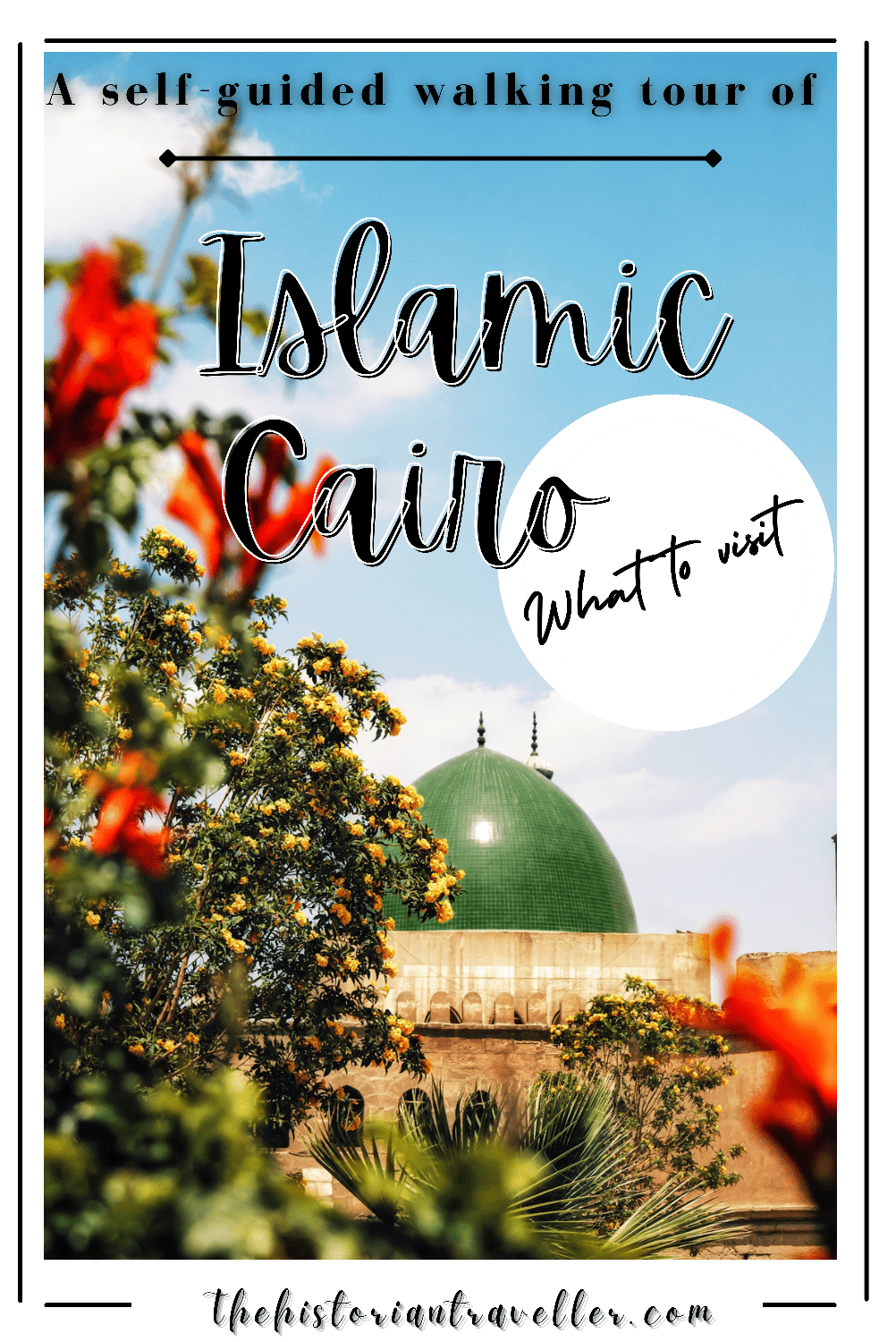Last Updated on October 28, 2023 by
Hello people! Welcome this new blog! This time I will talk about Islamic Cairo walking tour! Here I will show you the exact DIY walking tour I planned for me and Alessio during our stay in Cairo. You will find the best spots, practical information, maps and so on! Let’s start!
If you are planning an entire trip to Egypt check my survival guide here!
Table of Contents
Islamic Cairo, a timeless place
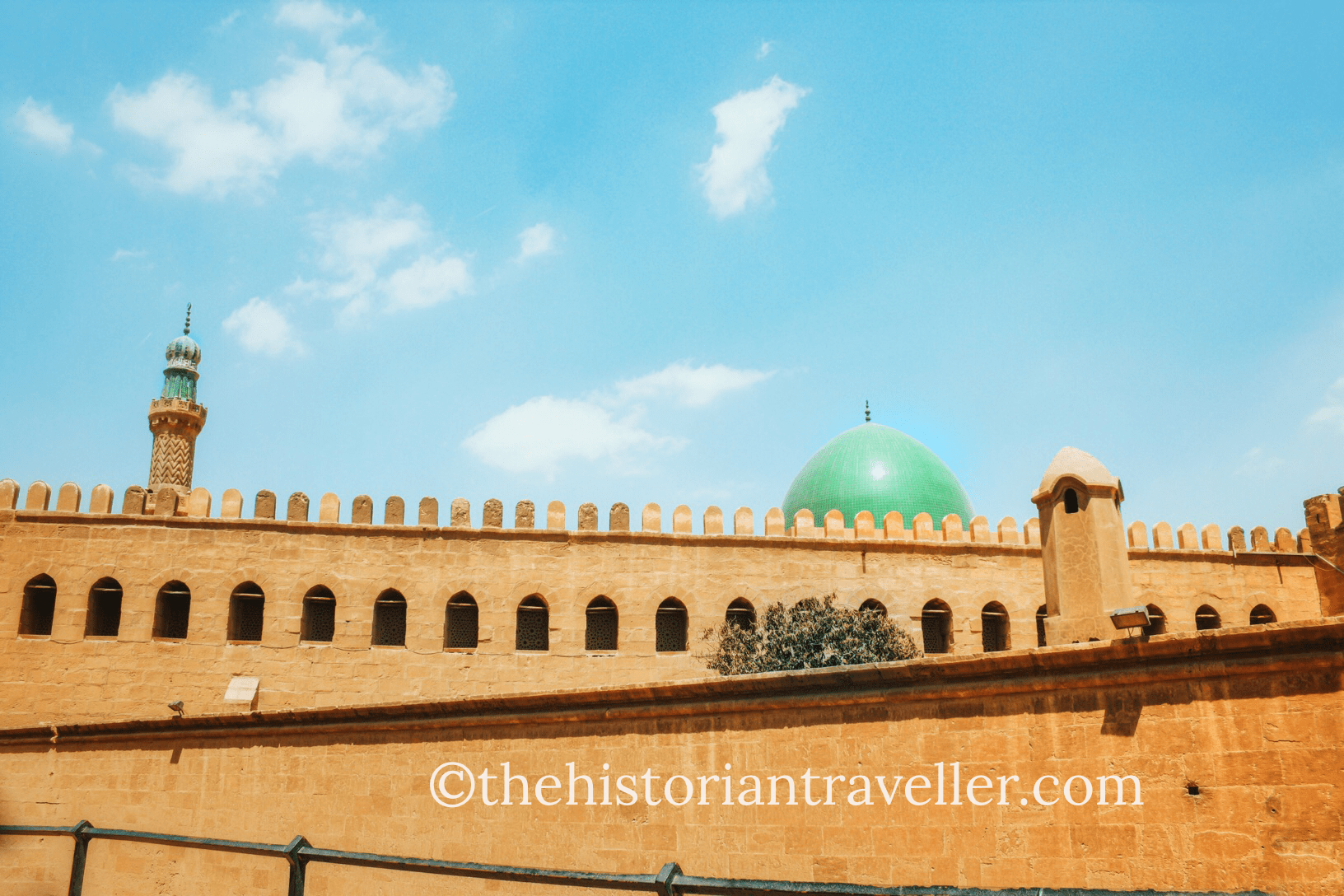
Islamic Cairo. Fascinating, old, beautiful. The first time I crossed one of those dusty, dark and little alleys I asked myself how many others have crossed these before? The Saladin troops? The pilgrims on their way to Alexandria? The merchant of spices? The British explorers? The Italian tomb raiders? I think there are not many places in which you can still feel history under your skin, but Islamic Cairo is certainly one of those.
The expression “travelling back in time” has surprisingly a new logic sense while I wander among colourful lamps enlightening dusty corners. There are exotic perfume shops and fascinating jewellery stores selling pharaonic-style necklaces like ice cream during a warm summer day. You can get literally lost in the never-ending Khan al Khalili souq and at one point, I wasn’t exactly sure where I was. This because the more you walk, the more Islamic Cairo looks like frozen in time and everything seems like out of a vintage ’50 movie.
In this mix of colours, sounds and smell of spices, I try to memorise every single corner, every single detail and unique place I see. I am not sure of when I could see all of this again. I loved Cairo since the first instant and I am sure it will gonna be one of my favourite cities in the world.
My travel booklet
What you’ve just read, are pieces of my travel diary re-adapted for the blog! In fact, I always travel with booklets where I note all the feelings I have when I travel to new places and I thought it was nice to use a part of my writings to describe you my first impressions of Islamic Cairo! Walking in Islamic Cairo was so far one of my favourite experiences and the only thing I regret is to not have spent more days exploring this complicated and wonderful city.
Islamic Cairo facts. 10 things to know
- 1) Islamic Cairo is known by local as قاهرة المعز (romanized as Qahirat al-Maez). The name “Islamic” comes from the high concentration of Islamic architecture in the whole area. This includes mosques, madrasas, tombs and fortifications.
- 2) In 1979, UNESCO declared the area of Islamic Cairo World Cultural Heritage site because it is one of the oldest Islamic centres survived since the Middle Ages.
- 3) Islamic Cairo is known also as “Medieval Cairo” because most of the architecture have been built under the Fatimid rulers during the Middle Ages.
- 4) Despite the pre-existence of former Islamic sites in the area the official date for the foundation of Islamic Cairo dates back to 969 with the arrive of the Fatimids.
- 5) Islamic Cairo has been founded with the scope of being a centre of culture and and intellectual Islamic tradition.
- 6) In order to be a centre of culture, the Fatimids founded the Al-Azhar University, the second oldest university of the world still operating since 988 A.D.
- 7) The first 12th-century Arabic version of Thousand and One Night (best known as Arabian Nights) was found in Islamic Cairo.
- 8) Islamic Cairo is home of the oldest mosque in the entire African continent: the Mosque of Amr ibn al-As built in 642 A.D.
- 9) The entire market of Khan el-Khalili was built on a pre-existent mausoleum known to be the burial site of the Fatimids and called “The Saffron Tomb”.
- 10) From a non-expert eye, the architecture of Islamic Cairo may look fairly homogeneous, but there are actually several building styles related to different historical periods (e.g. Fatimid period 969-1167 or the Ayybid Period 1189-1250 circa).
Getting around in Islamic Cairo
Islamic Cairo covers an area of 5,23 square kilometres, which is quite large to visit in just one day. It is advisable to use Uber or local taxis if you want to cover two or more distant areas, but if your plan is to see places that are close to each other, is better to walk. This because Islamic Cairo is one of the most densely populated area of the city, ergo is chaotic, loud and traffic is crazy.
It is likely that you reach first a place by walking rather than taking a taxi during rush hours. This happened to us and we regretted our decision because a 30 minutes walk (and a supposed 15 mins taxi ride) turned into a 50 minute taxi stuck in the traffic. Moreover, Islamic Cairo is connected to other areas of the city also by the Metro with the Line 2. The nearest station is Bab El-Shaaria (باب الشاعرية). If you are coming from Giza, consider that Islamic Cairo is at about 45 minutes distance. A Uber to the Citadel from Giza will cost you around 71-92 LE (3.30 – 4.30 GBP).
Walking in Islamic Cairo
I always thought that walking in places never visited before is the best way to explore the area and learn something new. It was the same in Egypt. However, I don’t want to give you the impression that walking in a city like Cairo is all peaches and dandelions, because it isn’t.
A challenging walk
The truth is that walking in Cairo is challenging and it isn’t for anyone. In fact, you must come prepared to face deadly pedestrian crossing, rivers of beeping cars, dirt (almost) everywhere, extreme levels of crowd (especially in the souq area) and vendors approaching you almost at every corner. Unfortunately, there are people who can bear with this without problems, there are people who can’t.
So, if you are too fussy to walk among bags of trash or you have to complain every two seconds because even crossing the street is a mission impossible, do a favour to yourself and go somewhere else. SERIOUSLY. I read way too many blogs and Instagram posts of people complaining about vendors, crowd or saying “I never seen a place so dirty..” and I can’t understand why these people still go around. If you want to stay in a place shining clean and without annoying stuff, stay home!
Remember always that Egypt is a developing country and there are still many things to improve, traffic and city cleaning are at the top of those. Maybe in 5, 10 or 15 years the situation will change completely but for now, if you want to visit, you have to accept the situation and come prepared. Having said so, if you are OK with all of this, it is still possible to organise a walking tour!
Islamic Cairo walking tour. What to chose
There are three main types of walking tour you can do: A) Self – guided walking tour, from which you can take inspiration from this guide! B) Free walking tour with a guide. They do exist also in Cairo. I haven’t tried any but if you want to have someone walking with you, you can find them here and here. Remember always that these tours are free but giving a guide a good tip is more than expected. C) Book a private/group guided tour. These are generally done with professional guides and cost around 50-72 $ per person. If you want to walk by yourself without any guide (as we did) if better to follow the 5 main rules below.
5 essential tips for your DIY Islamic Cairo Walking Tour
- Plan your itinerary IN ADVANCE. Before going out of your hotel, you should have already clear in mind what places you want to visit. Appearing disoriented and lost in a city like Cairo may increase the chance of people approaching you with the excuse of being your guide.
- Bring with you CASH, particularly pieces of 5, 10, 20 LE. They will be very useful to tip guardians or to pay entrance tickets at main attractions. Mosques are always free to enter. If anyone is asking money for this, he is trying to scam you!
- Bring comfortable shoes. You will walk a lot and sometimes in unpaved roads.
- Try to not look like a dummy tourist! Camouflage yourself is the key for having a tour without nuisance. This means avoid to walk with a city map on your hands, photographing every inch of the streets and stopping at every shop selling fake papyrus.
- Be respectful. Remember always you are visiting an Islamic country so, respect their customs and cover yourself! Don’t go around in shorts or like you are attending a party at Miami beach. If you are a woman, remember to bring a scarf to cover your head (particularly inside mosques). Remove your shoes BEFORE entering inside every mosque or religious complex and if one of those places is closed because of prayer times, don’t be rude and start complaining loudly in front of the main door.
Exploring Islamic Cairo
There is a huge concentration of historical sites in Islamic Cairo. This means that one day is not enough to see everything. In order to have a proper understanding of the stylistic evolution of the Islamic architecture and a comprehensive vision of the historical significance of the area, it is better to spend in Islamic Cairo 2-3 days.
Because of our tight schedule, I deeply regretted to have dedicated to this part of the city just one day, as there is so much to see and experience! In fact, on a future trip to Egypt, I will probably spend more time in Cairo and less across the country. Anyway, if you have just one day, like us, you can cover the same the main areas of Islamic Cairo, and see at least the most famous mosques and historical sites.
The itinerary
In our one-day Islamic Cairo walking tour, we planned a DIY itinerary allowing us to visit the following sites.
- The Citadel (not in the map below)
- Bab al-Futuh (A)
- Bab el Nasr (B)
- Muizz Street (A-D)
- Al-Hakim Mosque (C)
- Qalawun Complex (D)
- Midan Hussein and Sayyidna Al-Hussein Mosque (exterior only) (E)
- Khan el-Khalili (F)
- Al-Azhar Mosque (G)
- Al-Azhar Park (H)
Islamic Cairo Sites and Walking Map
Start from the Saladin Citadel at early morning. We reached the Citadel by taxi from Giza and our visit lasted around 2 hours and a half. After that, from the Citadel you can take a taxi to point A (Bab al-Futuh) as we did or follow the reverse route from point H (Al-Azhar Park). In theory, this should be a 13/16 mins ride (cost 28/35 LE) compared to a 50 mins walk.
However, it is better to check the amount of crowd on the roads. If it’s too crowded, it may be worth (and quicker/same amount of time) to walk instead of taking the taxi. We did the wrong choice in this case. Because we stayed the same amount of walking time in the car sweating and regretting our decision. Bab al-Futuh (A) is far from the last point, A-Azhar Park (F) 2,5 km circa (30-36 mins walk).
You will reach this through Muizz Street visiting in the meantime points C-G. This will require 2-4 hours depending on your pace. We stopped along the way to have lunch (1h). Al-Azhar Mosque (F) is at a 20 minutes walk from Al-Azhar Park (G). We left this for last because we wanted to watch the sunset from the Park that is situated in one of the highest points of Cairo.
The Citadel – قلعة صلاح الدين
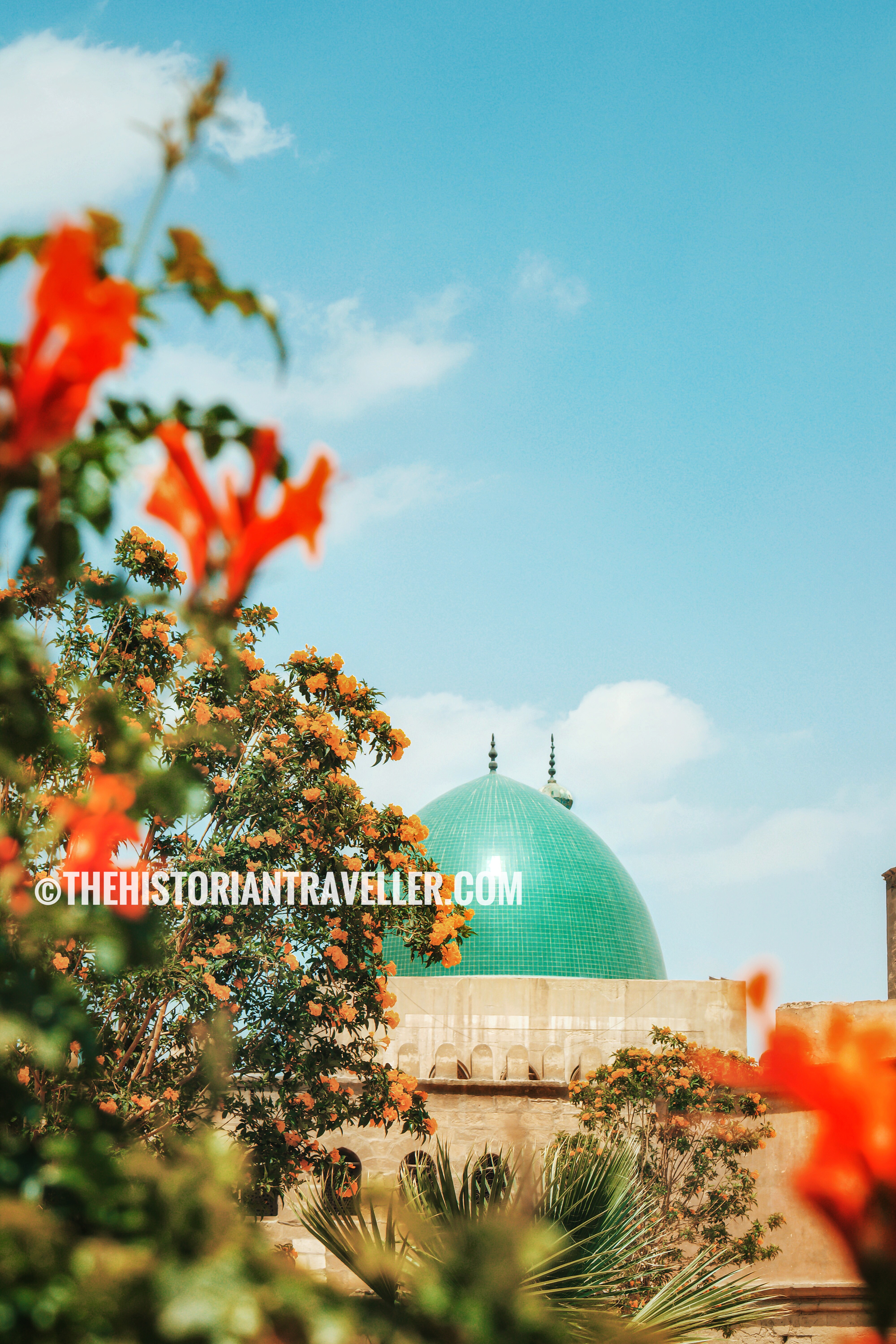
The Saladin Citadel was at the top on my list of places to visit in Cairo. I knew it deserved a good portion of the morning to be fully appreciated. For this reason, it was the first stop of our DIY walking tour of Islamic Cairo. Many people confuse the Saladin Citadel with the Mosque of Muhammad Ali. However, the Citadel is actually a much bigger fortification that includes the Mosque of Muhammad Ali and several other buildings.
Read More! There is a special blog on the Saladin Citadel! Here, you can find all the information you need for your visit! Click here to read it!
Because of our tight schedule, we visited just a couple of sites inside the Citadel and this took already 2 hours and a half. However, if you want to visit all the sites inside the fortified city, you will probably need three or four hours.
Saladin Citadel facts
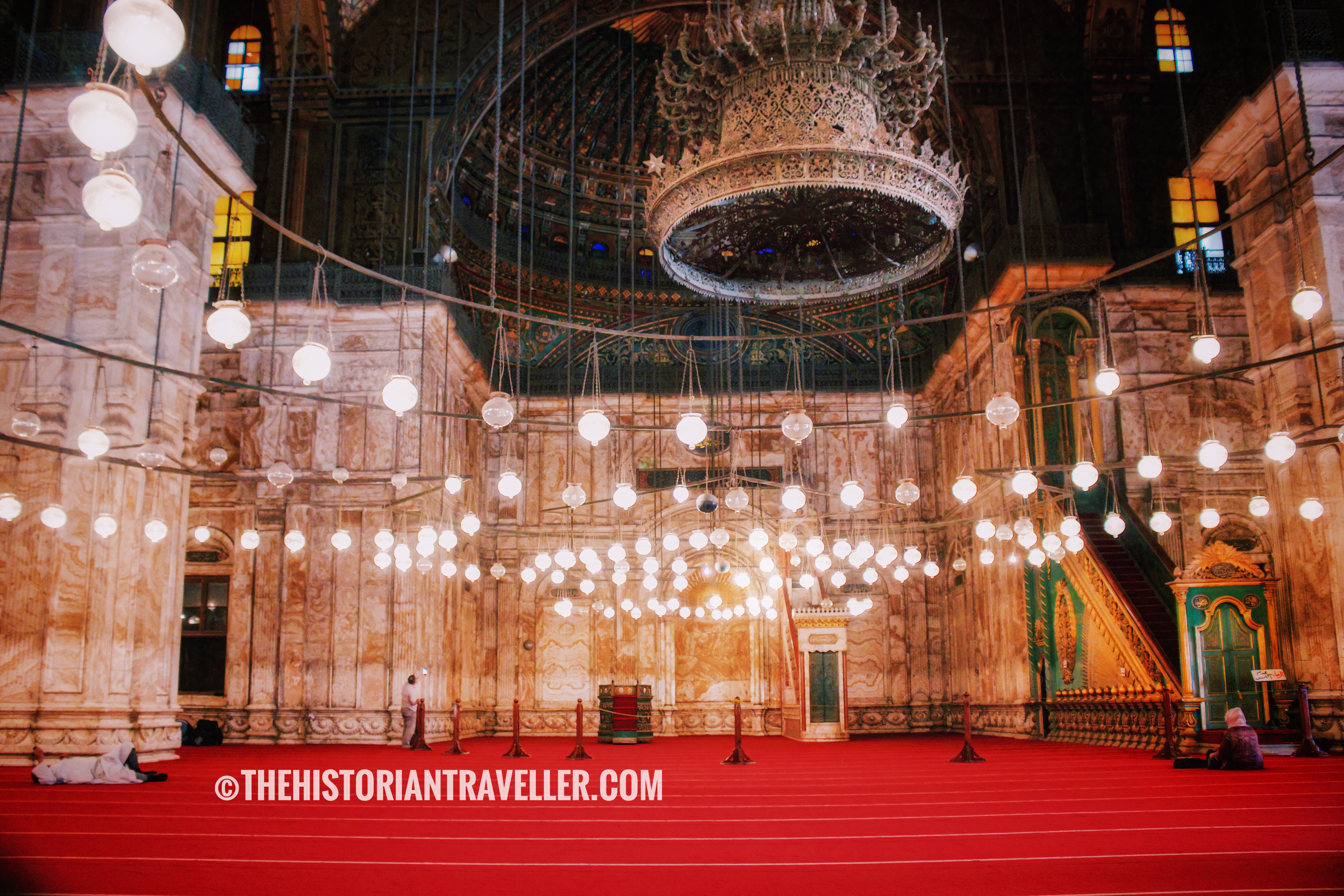
- The original structure of the Citadel, (the one commissioned by Saladin), dates back to 1176-1183 AD
- The Citadel was the “administrative” home of the Egyptian rulers for more than 700 years
- Because its original scope was that of being a defensive structure against the Crusaders, the Citadel was built in one of the highest point of Cairo.
- The Citadel is a UNESCO World Heritage site since 1979
- Many people confuse the citadel with the Mosque of Muhammad Ali. Nevertheless, the mosque dates back between 1830-1848 and it’s now part of the already preexisting structure.
- There are three mosques inside the Citadel and also three museums
- The Citadel is one of the most famous landmarks in Cairo, after the pharaoh-related monuments.
Saladin Citadel practical information
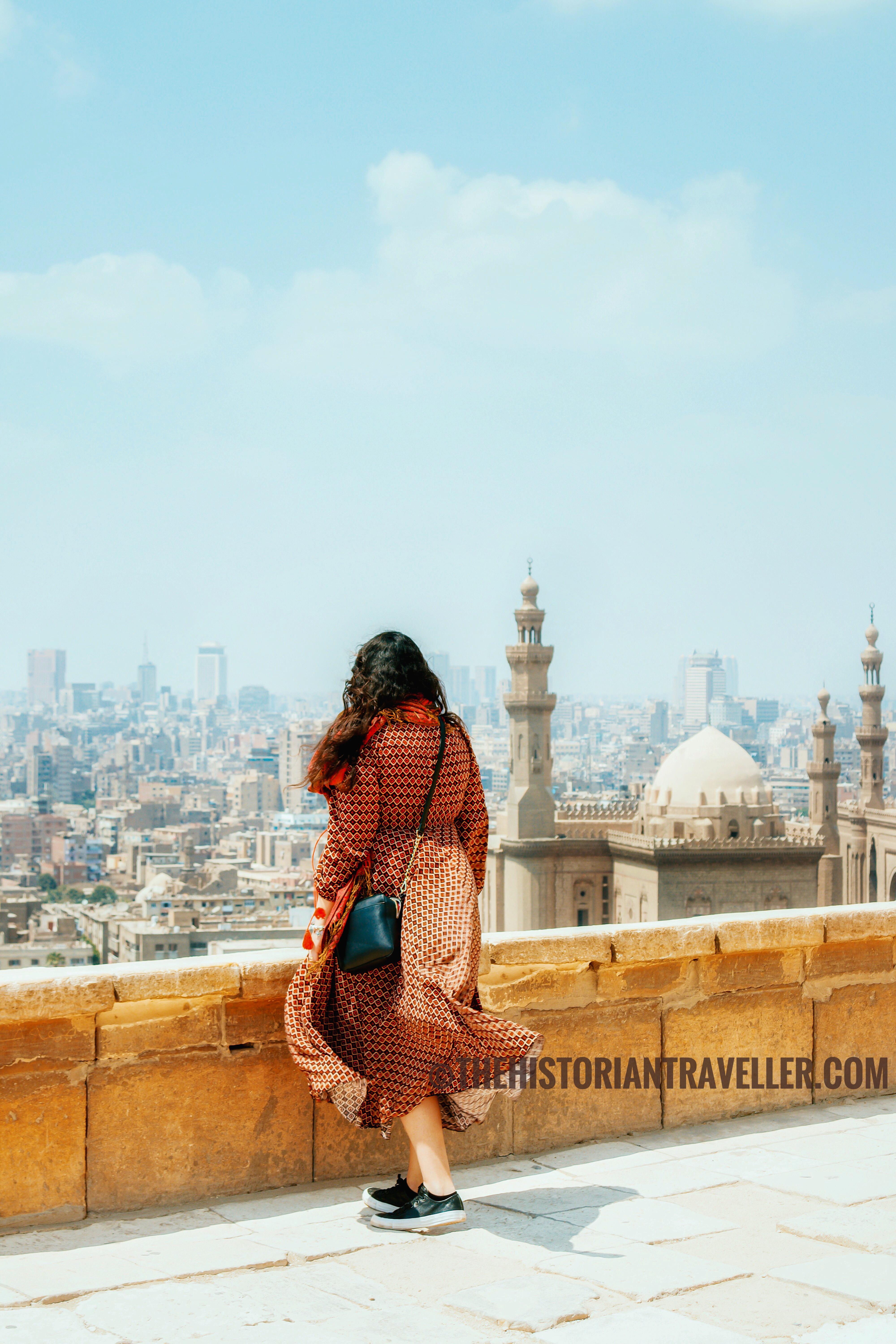
How to get to Saladin Citadel
The Saladin Citadel is situated at the top of Mokattam Hill. The precise address is Al Abageyah, Qesm Al Khalifah.
If you are coming by taxi, and your driver don’t understand the location in English, use its Arabic name Qalaʿat Salāḥ ad-Dīn – قلعة صلاح الدين
The cost of a Uber from Giza is of about 71-93 LE (£ 3,5 – 4,5). The ride may take between 36 and 50 minutes depending on the traffic.
Entrance fee and Opening times
The entrance ticket is LE 140 (70 for students) £6,5 circa. There is a different price for special night visits. This is LE 160 ( 80 for students) £ 7,5 circa.
The student ISIC card is valid but if you look older than 20 years old, the guy at the ticket counter start complaining that you can’t use it. OBVIOUSLY, IT’S NOT TRUE. In fact, if you are a student, have an ISIC card and currently pay taxes at your university, you can obtain a student discount. Don’t let the guy intimidating you. Insist to have your rights respected.
The Citadel is open MON-FRI 8 am-5 pm and SAT-SUN 8 am – 4 pm. During Ramadan the complex closes at 3 PM.
Friday prayers start at 12 pm. You can still visit the citadel but it’s not recommended. The place is quite busy and you may disturb the prayers wandering around.
Attire
Wear conservative clothes. Don’t go in shorts and don’t even try to wear sleeveless t-shirts if you are a woman. You are inside a Muslim location and you must respect the dress-code. Women should cover their head with a scarf inside the mosques (is not compulsory but highly recommended).
Remember is forbidden to wear shoes inside all the mosques and sacred adjacent courtyards. If you don’t like to walk barefoot, bring a pair of socks.
Other useful info
There might be “unofficial” guides attempting to approach you for guiding you around. Kindly refuse and go on.
There are toilets situated near the Al-Nasir Muhammad Mosque. You won’t find either toilet paper or soap. These are under the control of the cleaning lady/man who will give some to you for a small tip. 5 LE are usually a good tip in these occasions.
You will pass two different types of security checks. A body scanner at the first entrance gate near the main road and a bag/body check near the ticket counter.
Walking on Muizz Street – شارع المعز
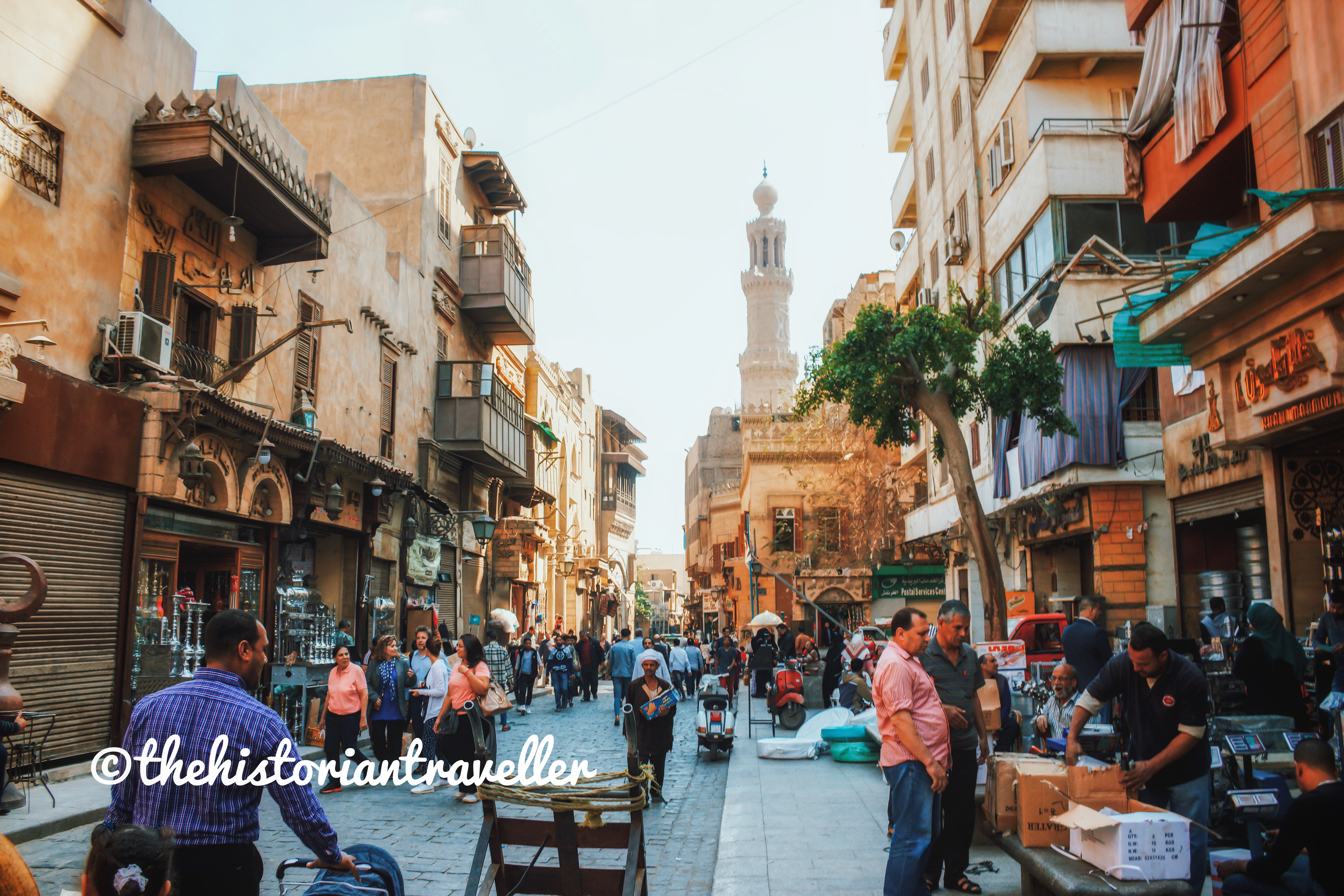
After your morning at the Saladin Citadel, is now time to move to a very interesting part of the city. The beating heart of Cairo and probably also its most photographed place. (Al) Muizz Steet.
Al Moez Ldin Allah Al Fatimi Street, best known as Muizz Street, is one of the oldest streets in Cairo. As you will see, it’s crowded, picturesque and full of historical buildings. Local people call it Shareʻ El Muizz and these words sounds quite funny when pronounced by westerners.
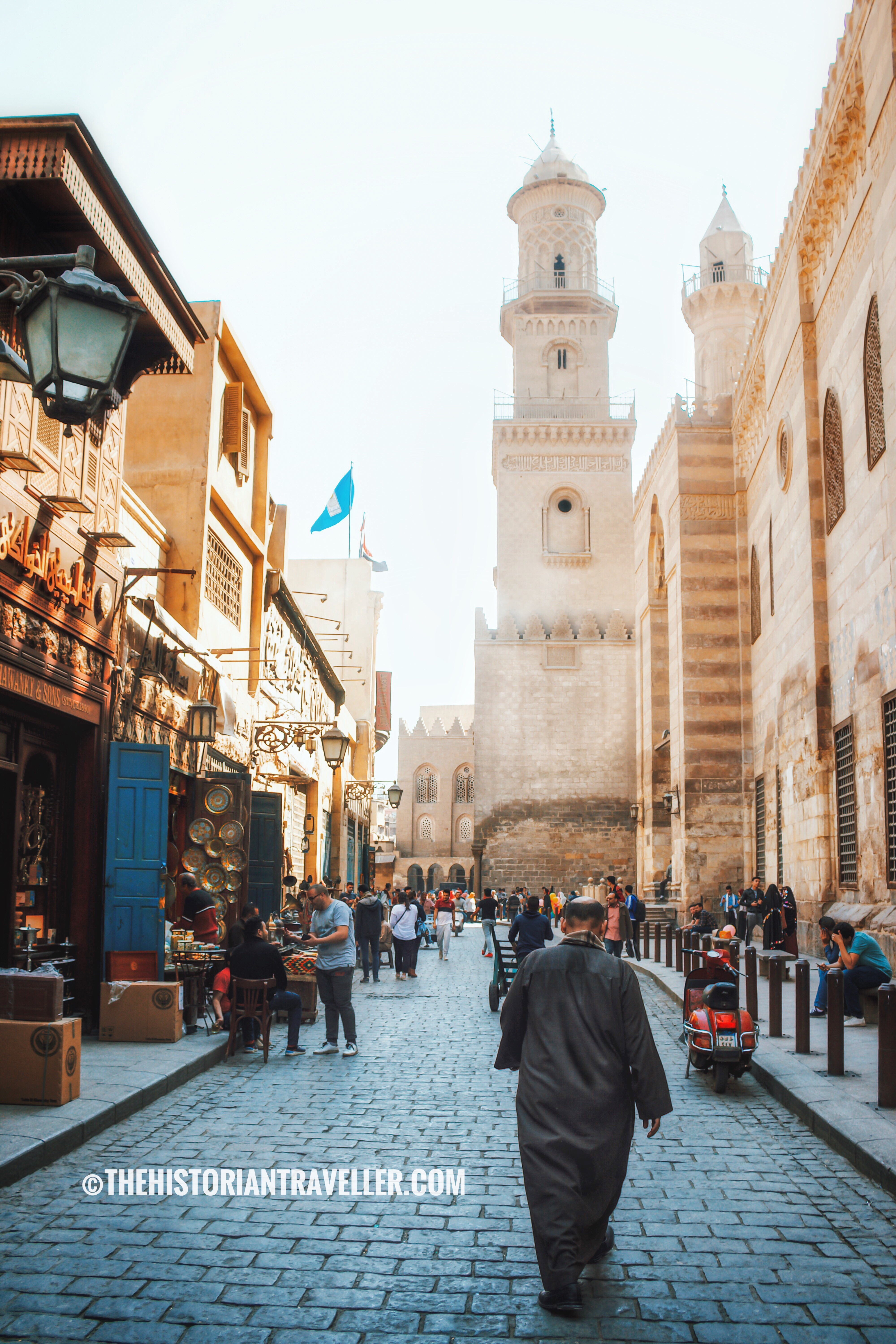
If you are staying more than two days in Cairo, I warmly suggest you to dedicate an entire day to explore Muizz Street and its incredible number of Islamic sites. In fact, it looks like Muizz Street have the greatest concentration of medieval architectural treasures in the entire Islamic world. The street stretches for about 1km, going from Bab al-Futuh to Bab -Zuweila (circa).
Muizz Street will be your landmark during your Islamic Cairo walking tour and the place you can return in case you get lost. From here, you can practically explore all the places I indicated on my list, find a great spot for lunch and take amazing pictures.
Al-Hakim Mosque مسجد الحاكم بأمر الله
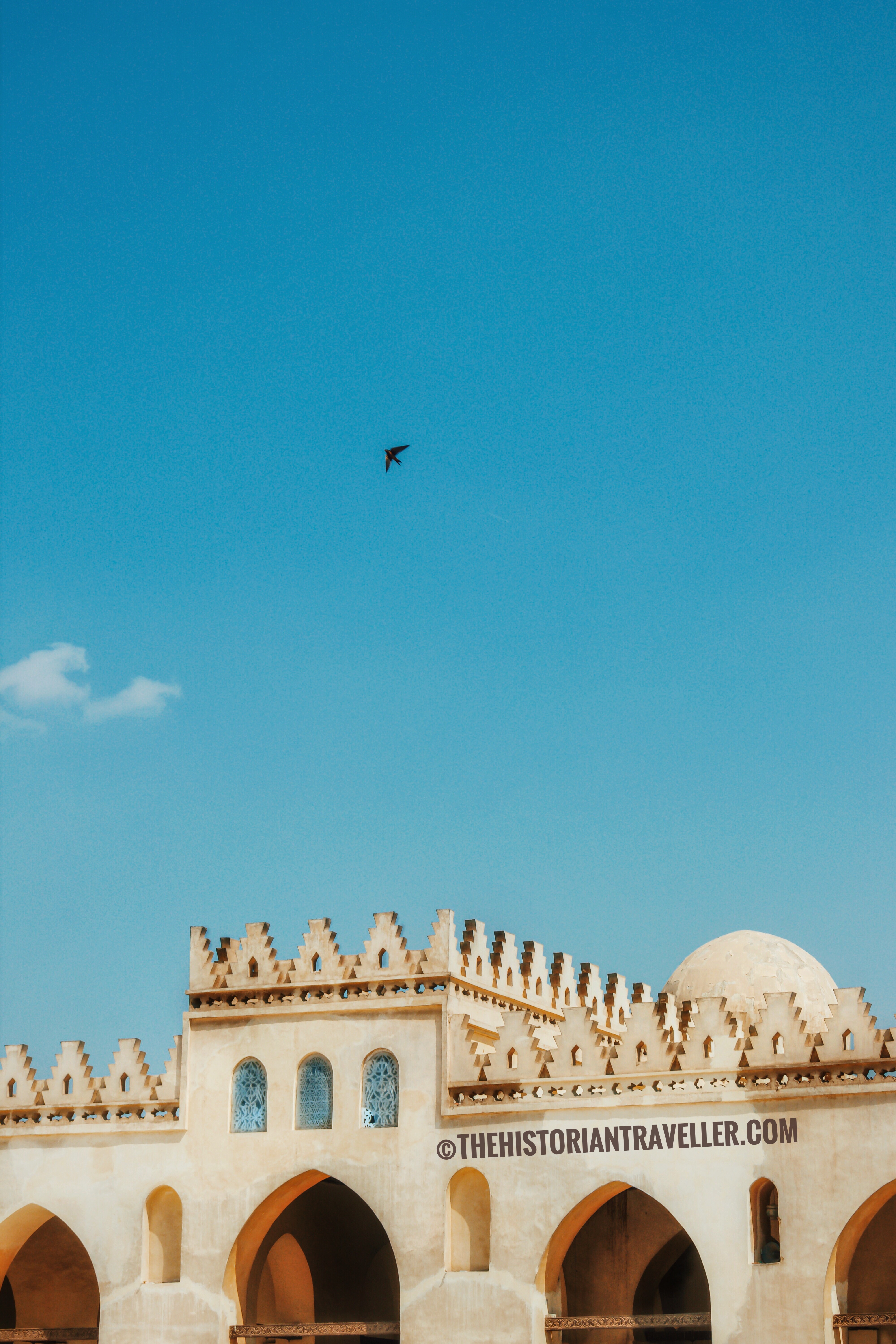
If you arrive in Muizz Street from Bab al-Futuh, the first must-visit sight on your Islamic Cairo walking tour will be the Al-Hakim Mosque.
Facts about the Al – Hakim mosque
- This mosque, famous also with the nickname al-Anwar, which means “the illuminated”.
- It is one of the oldest in Cairo and also the second largest Fatimid mosque in the city.
- The construction dates back to 990 AD and completed in 1012.
- It features an unusual architecture because the entire mosque is built in white brick, while the minarets are in red stone.
- It looks like the original minarets (in white brick) are hidden under the current ones. This because Al-Hakim was an eccentric man and disliked the former minarets built by his father.
- The architecture of the mosque is inspired by Tunisian architecture of that period.
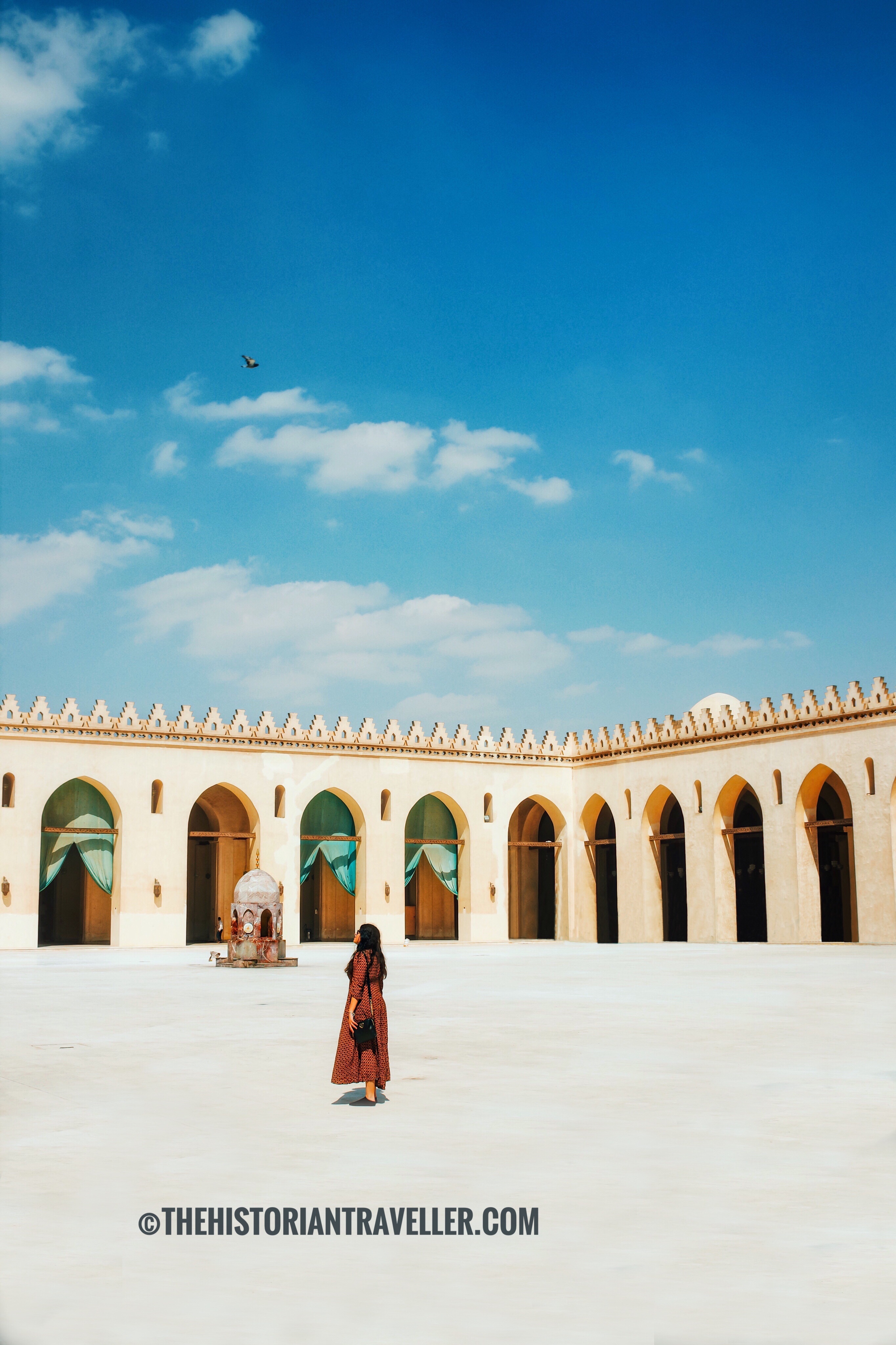
Visiting the Al-Hakim mosque is very simple as you have just to pop in from Muizz Street. The visit to the mosque is FREE. However, note that in this moment, the mosque is under renovation. For this reason, you can find some difficulties to walk barefoot on the courtyard. In fact, there are debris and work material around.
Qalawun Complex
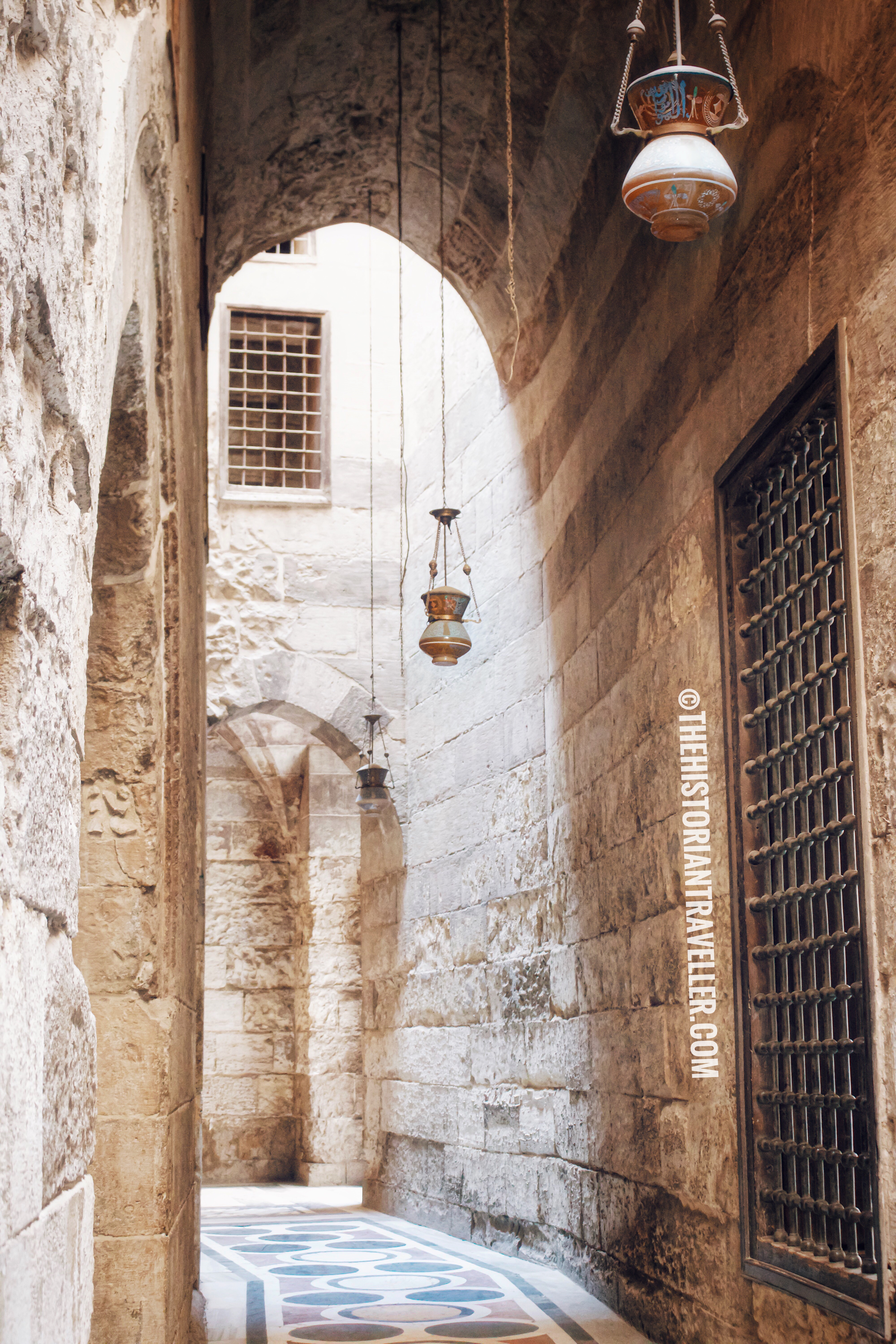
Qalawun is another must-visit location on your Islamic Cairo walking tour. This is a huge Islamic complex. Above all, it features a madrasa, a mausoleum and a hospital. The complex dates back to the thirteenth century, commissioned by the Sultan Al-Nasir Muhammad Ibn Qalawun.
Qalawun complex is not free to enter (although a ticket counter is not immediately visible). There is a general ticket of about 100 LE granting you the access to most places in Muizz Street.
Khan el-Khalili
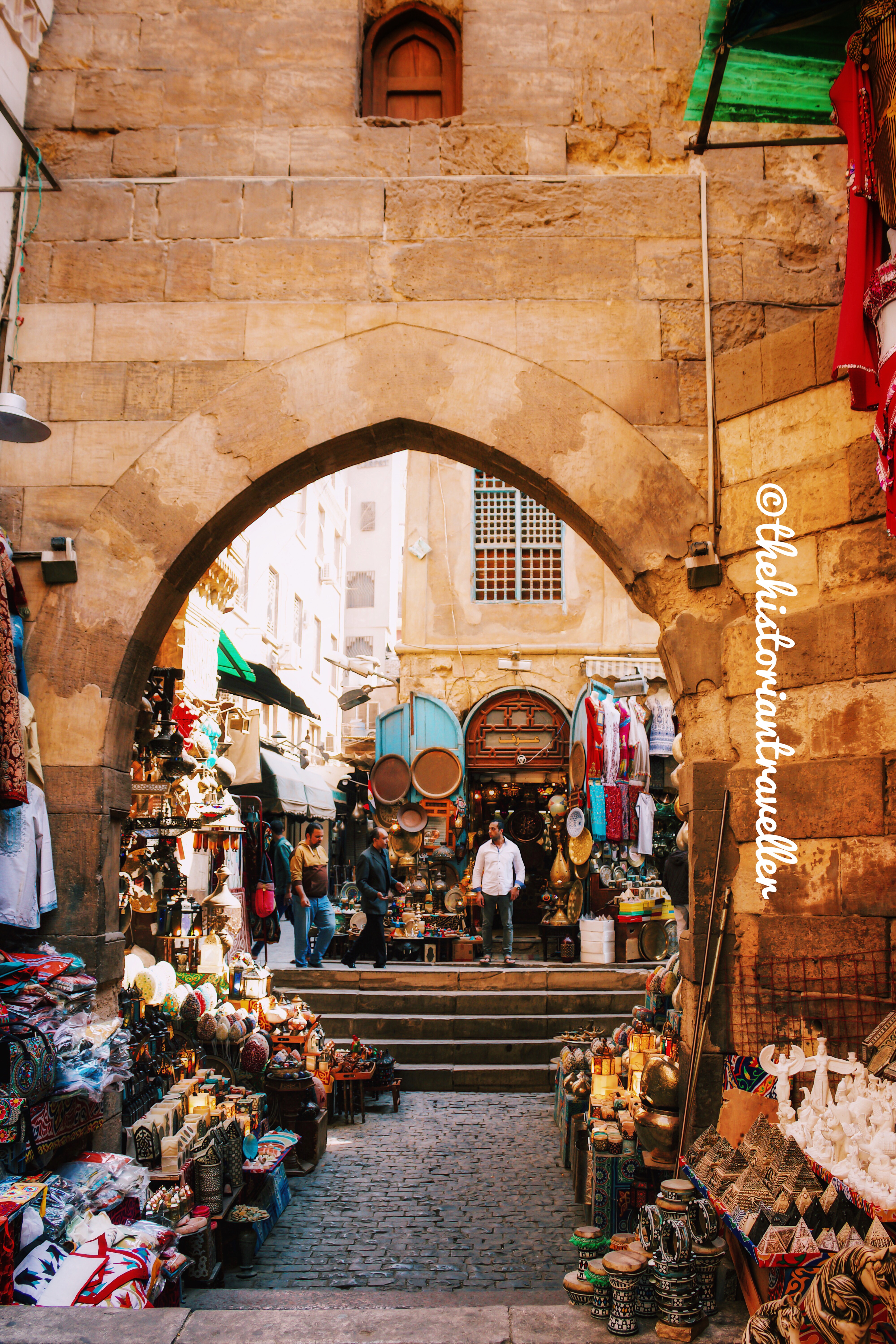
Khan el-Khalili was one of the highlight of our Islamic Cairo walking tour. It is a major souq (market) in Cairo and probably also the most interesting one. In fact, you will notice immediately that it looks straight out of a fairy tale and, in my opinion, this is probably the most photogenic market ever.
The Saffron Tomb
When you step into it, look up. You will see some magnificent examples of Islamic architecture built between 970 AD and 1500. Gates, arches, mysterious alleys. It looks like an Indiana Jones movie out there, but it’s totally real! This market is so visually beautiful because it is built inside a Fatimid Mausoleum. In fact, this is called the “Saffron Tomb” and it was the burial place of the Fatimid caliphs.
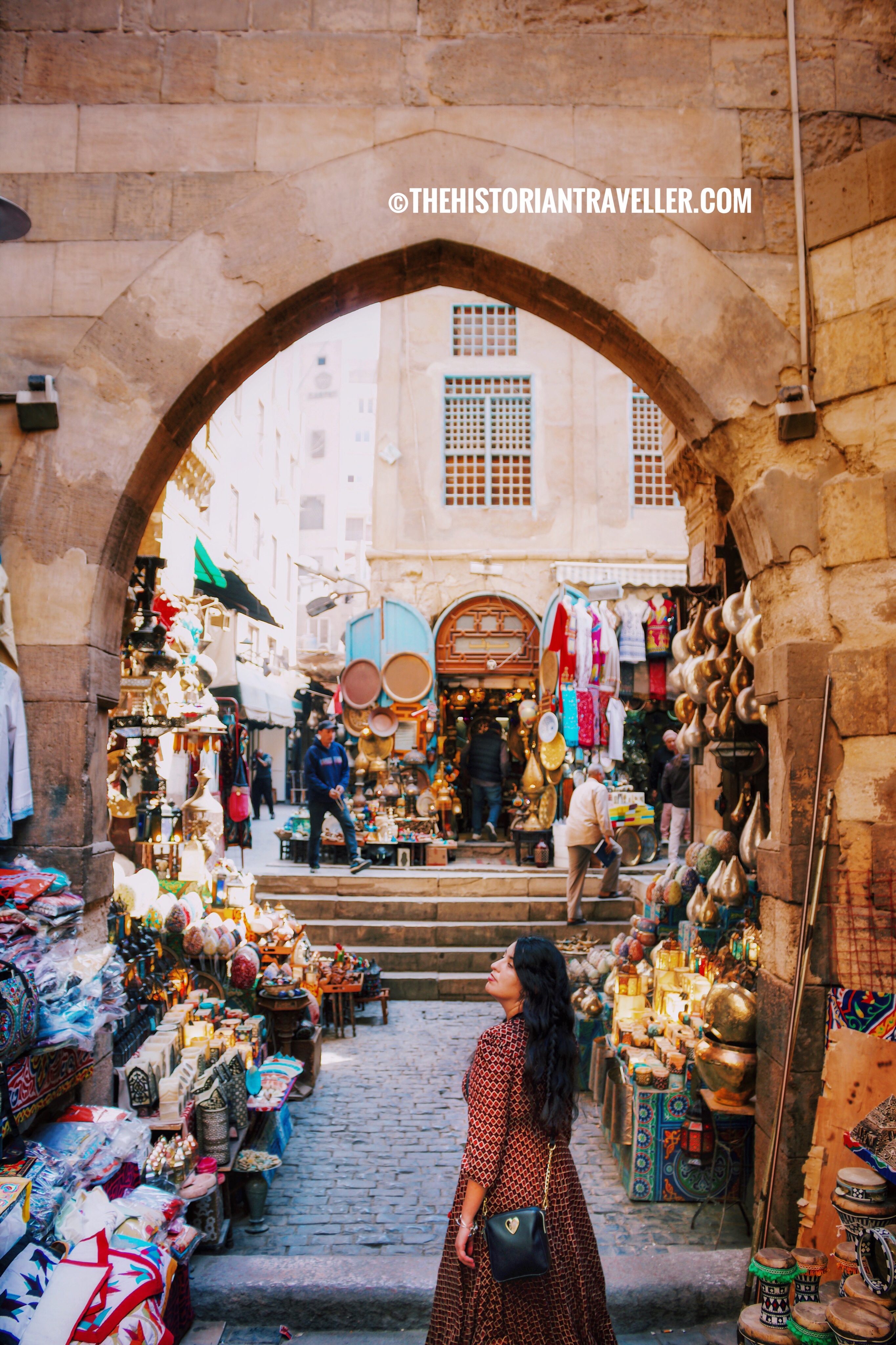
In 1382, Jaharkas al-Khalili demolished great part of the old mausoleum to build a Khan. A place where merchants could sell their goods. After that, the khan expanded in the 15th century, becoming a major centre for foreign trade. The major good sold were spices, precious stones, papyrus and slaves. However, the original khan built by Jaharkas al-khalili was demolished in 1511 to make space for a bigger and most organised market.
This had a central major bazaar and ornate gates that were locked at night. Most of these gates are still visible today (you need just to walk with your nose up in search for them!).
What to do in Khan-el-Khalili
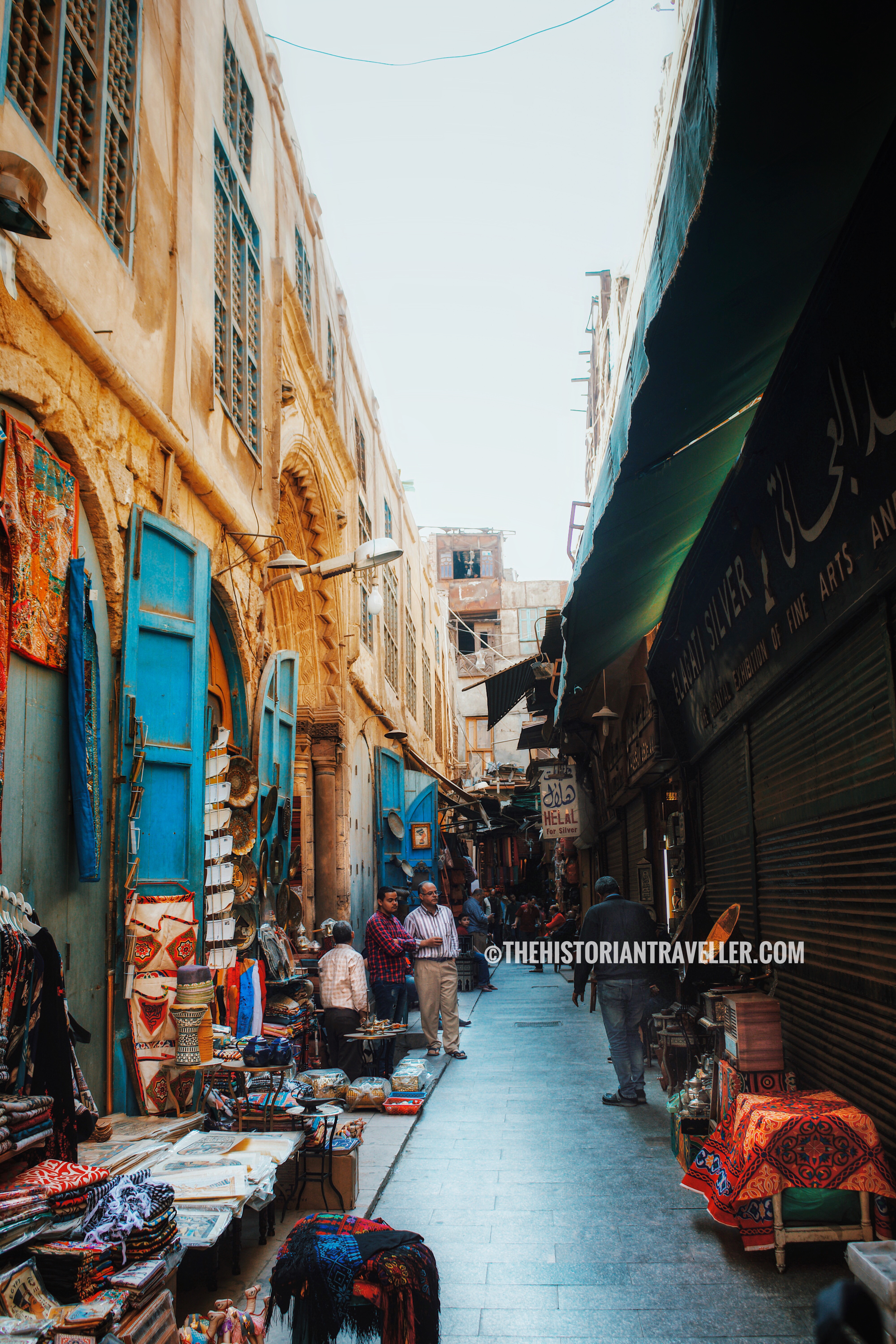
Khan-el-Khalili is the ideal place to walk and get lost. Now, most of the shops sell souvenirs, lamps and home-related goods. However, if you search well, you will notice some old goldsmith shops and papyrus makers still in activity. Moreover, there are also old bookshops that are very fascinating! These sell mostly religious books for the nearby Al-Azhar University but I loved to see them around.
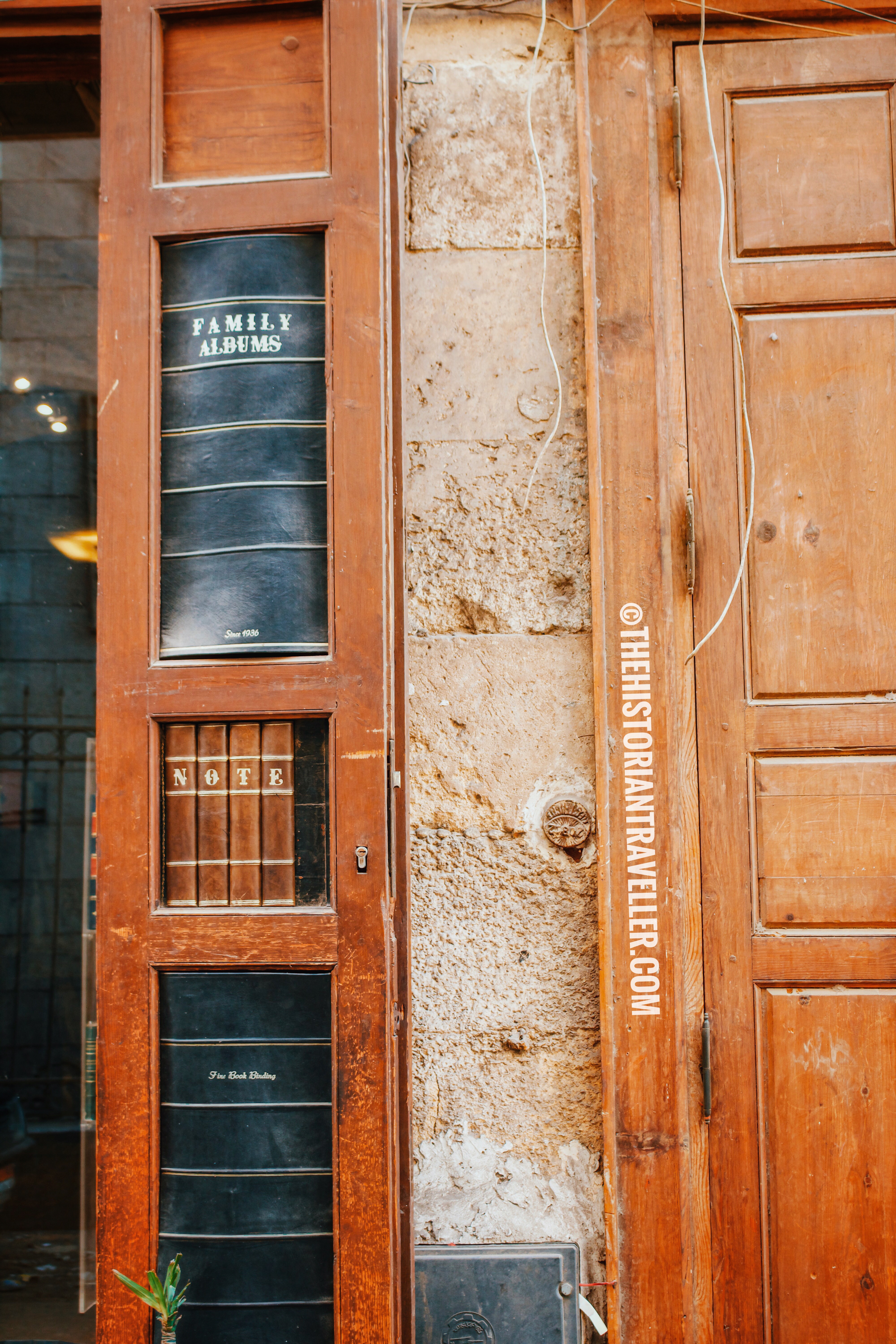
Cafe culture
One of the things you can’t miss at Khan-el-Khalili are the amazing historic cafes. In fact, These are the essence of old, historic Cairo and one of the highlight of the Islamic Cairo walking tour. For instance, El-Fishawi cafe is one of the oldest cafes of Cairo. It dates back to 1977 and has that old-movie mood typical of the streets of Cairo. However, El-Fishawi cafe is usually quite busy. Therefore, if you can’t find a space you can go in the nearby Khan-al-Khalili cafe. This is less famous than its neighbour but serves anyway a good coffee. The negative side is that the menu is very overpriced compared to other cafes in Cairo.
How to reach Khan-el-Khalili
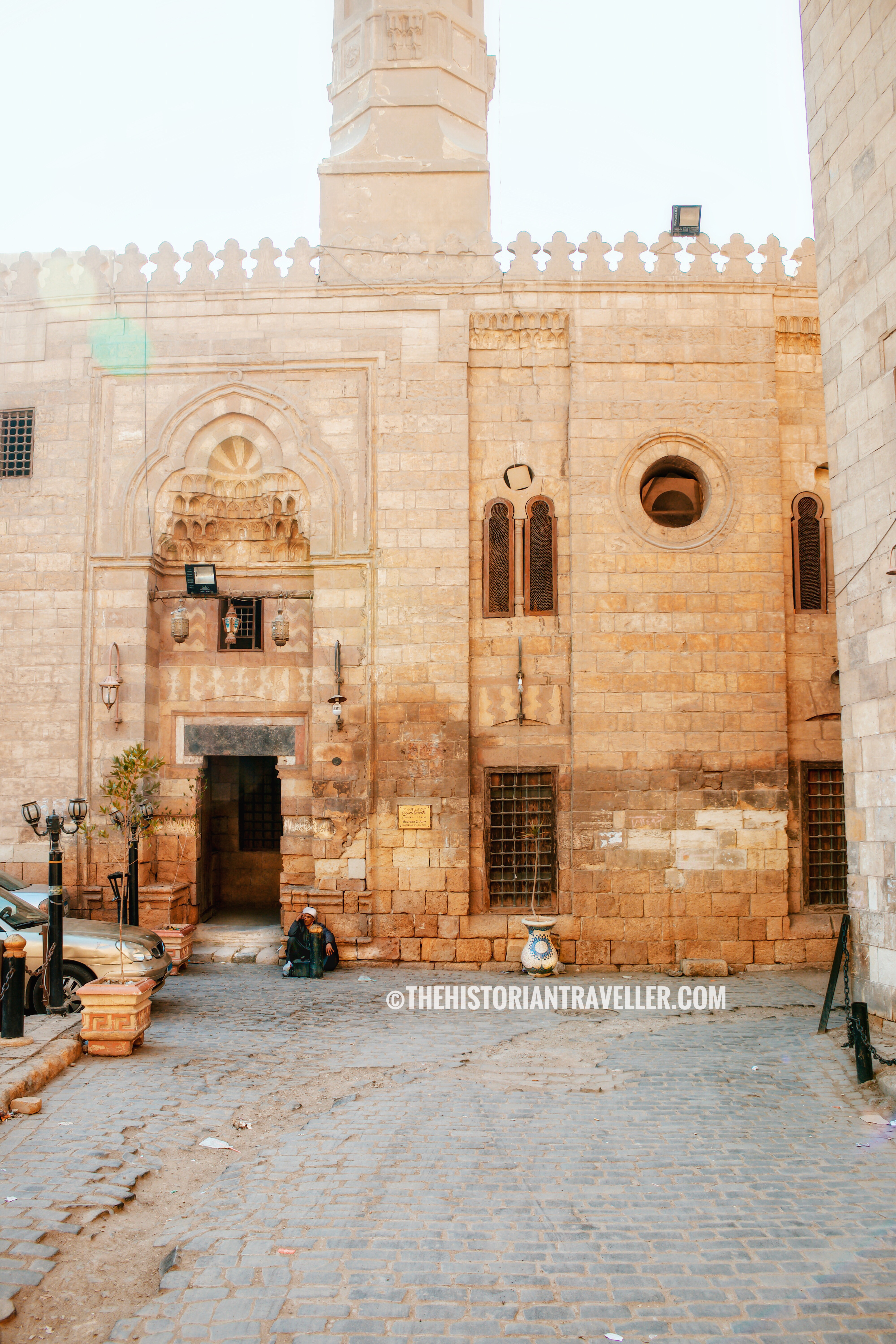
Khan-el-Khalili is reachable only on foot from Muizz Street or one of the streets nearby. This because it’s a pedestrian area, therefore cars are not allowed. However, if you are going by taxi you can stop just out of the city walls and walk. It shouldn’t be more than 10/15 mins walking.
Al-Azhar Mosque
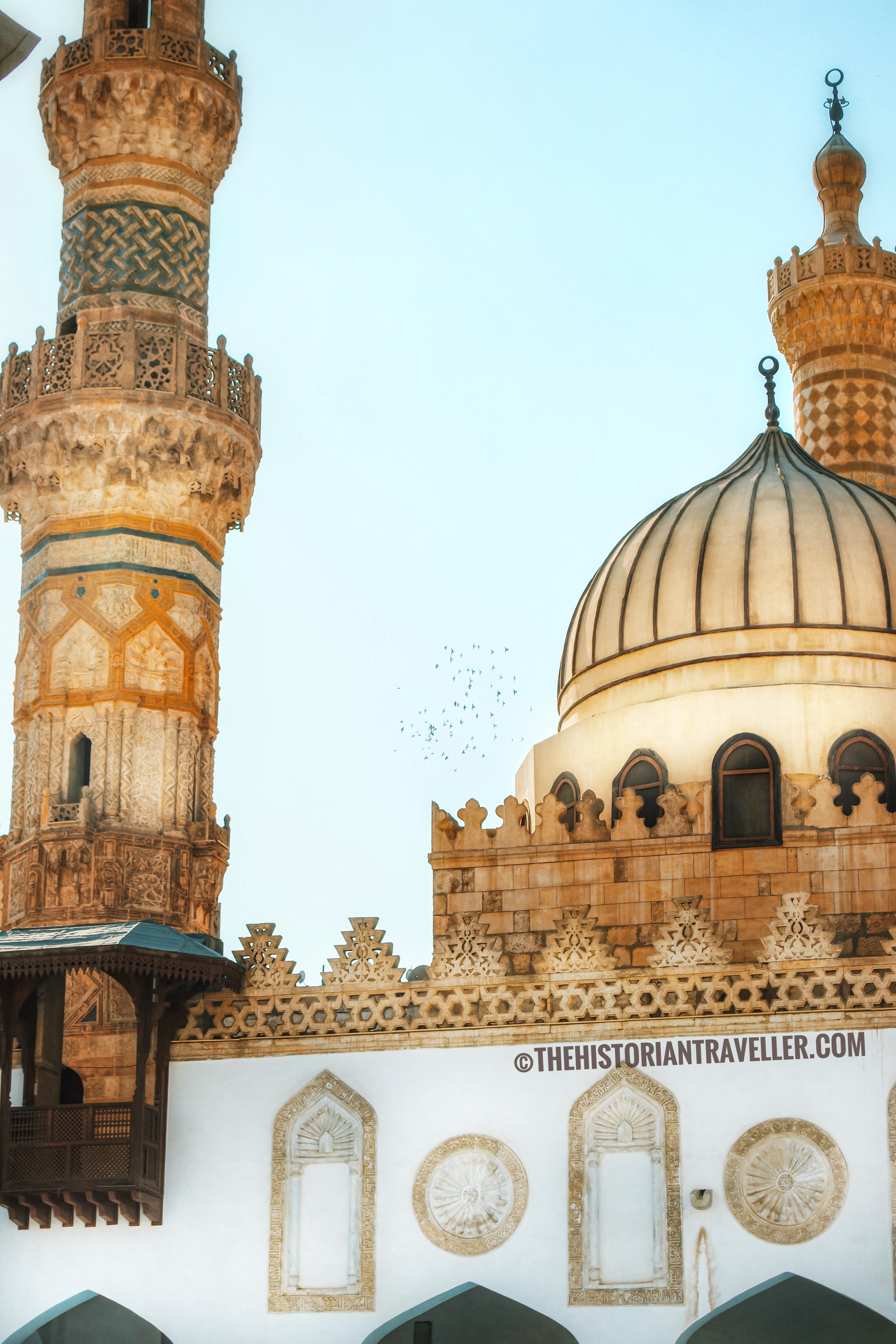
Soon after lunch, (for where to eat in Cairo see below), our first stop on our Islamic Cairo walking tour was the beautiful and immense Al-Azhar Mosque. If I look at the picture I still can’t believe this place is so old! In fact, the mosque was completed in 972!
The second oldest university in the world
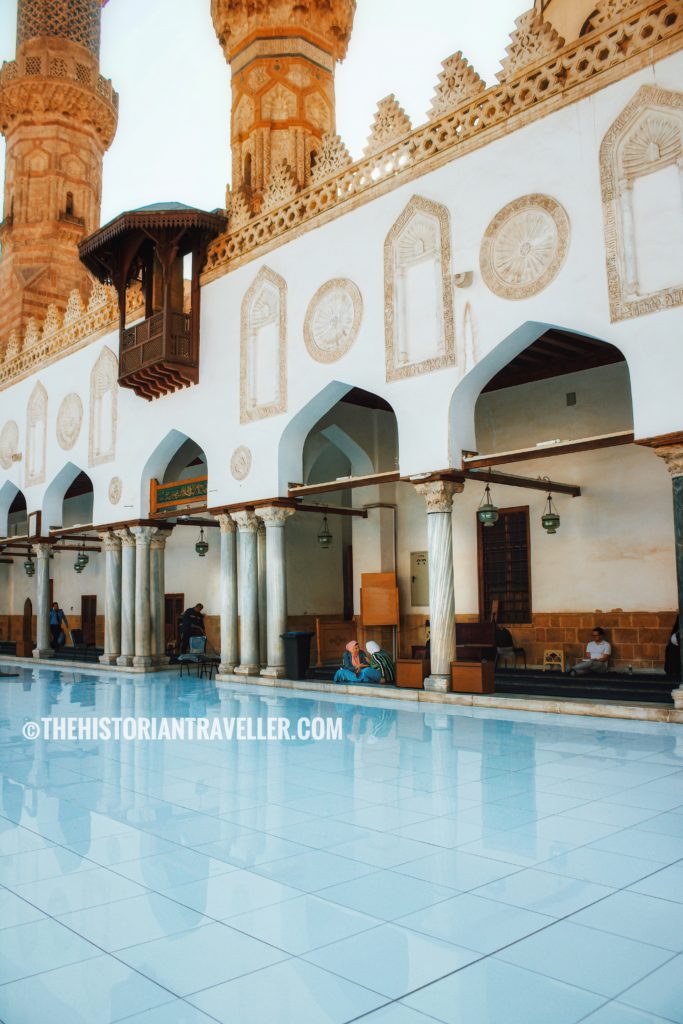
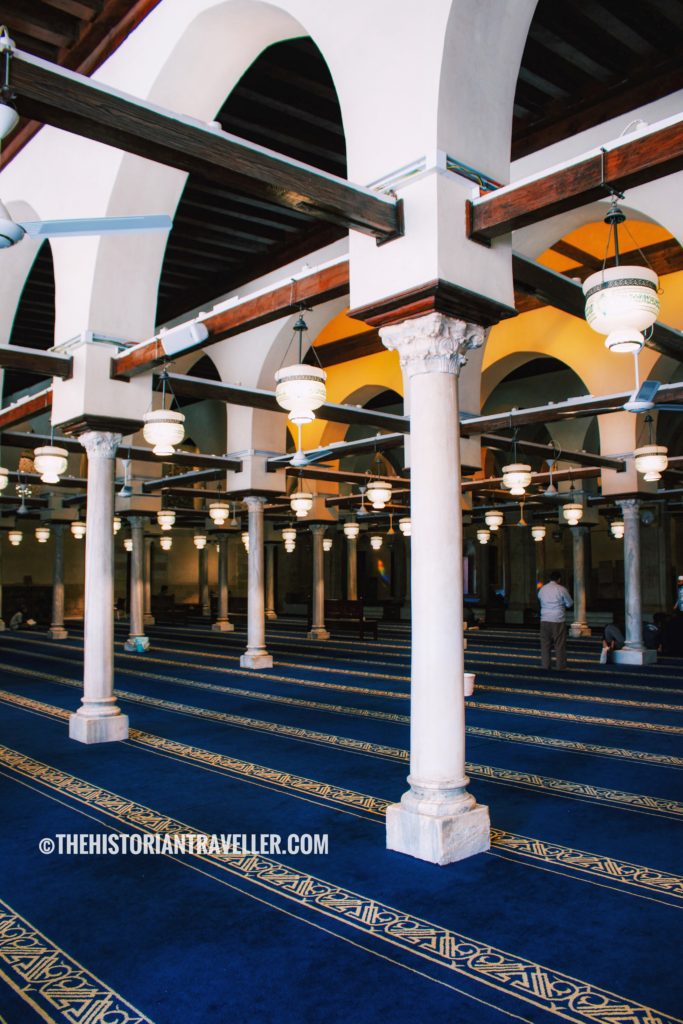
Yes, you read well. Not Bologna, not Paris, not Oxford or anywhere else in Europe. The oldest universities in the world are elsewhere! In fact, the first is in Al Karaouine in Idrisid Fes (Marocco) and the second it’s here in Egypt and it’s the Al-Azhar Mosque.
After its dedication in 972, the mosque slowly developed into an educational institution, which run continuously since the early middle ages. Al-Azhar Mosque is also been regarded as one of the foremost institution for the study of theology, sharia or Islamic law.
Tips for visiting Al-Azhar Mosque
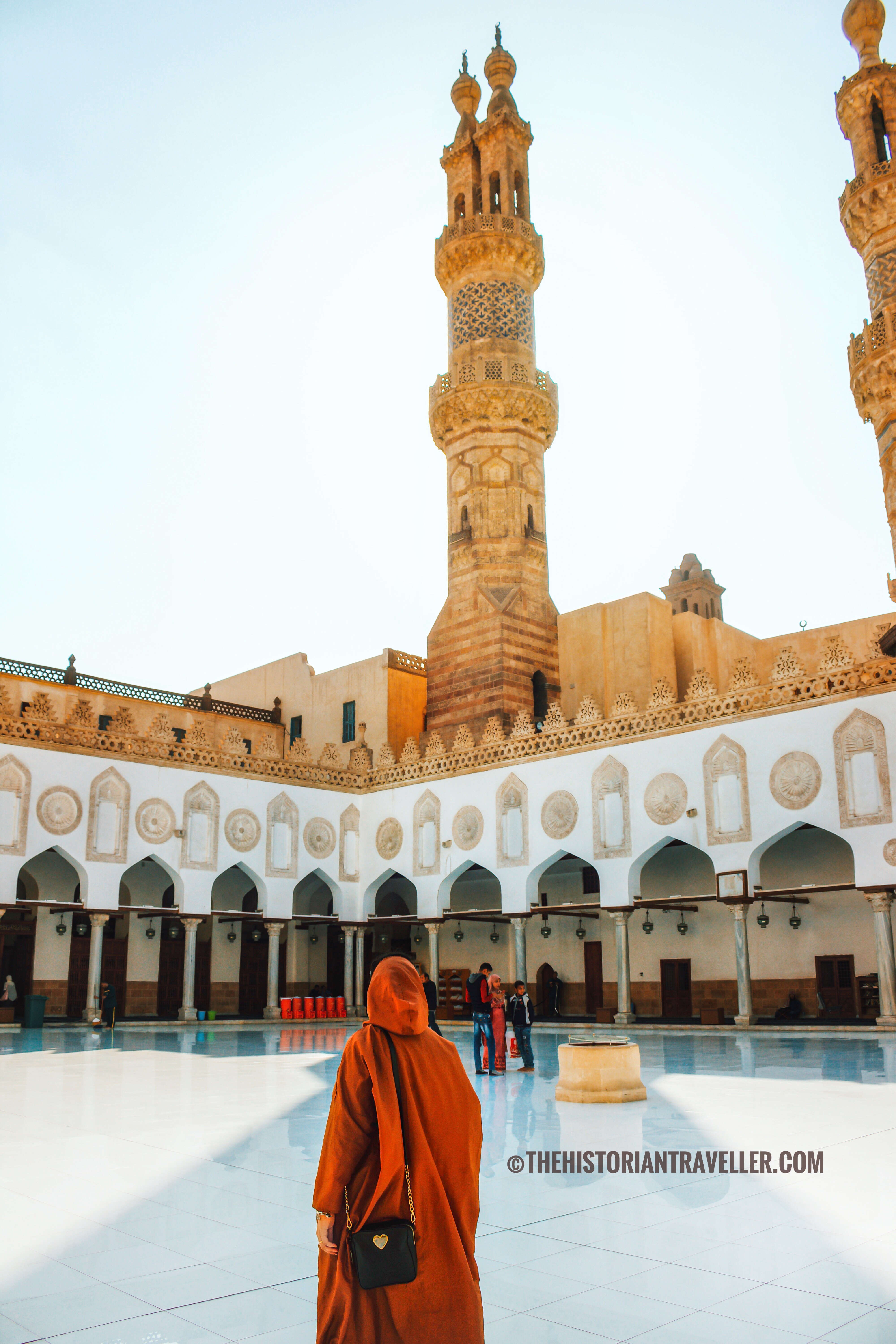
- Being an active running university Al-Azhar Mosque might be quite crowded. In fact, we found lots of students but also families and children enjoying their time in a safe and quiet space. If you want to catch the shiny reflection of the floor without any people, it’s better to go at early morning or far from the prayer (when more crowd is generally expected).
- Al-Azhar Mosque dress code for women is much more restrictive than other mosques in Cairo. As you can see from the picture, I had to cover myself completely. You can rent one of the clothes covers at the entrance for free (don’t forget to tip the attendant).
- Wearing shoes is obviously forbidden, but here is even more strict due to the shining white floor that is carefully cleaned literally every 5 minutes.
- Entrance is free. If anyone is asking you money, it’s a scam!
- Don’t forget you are inside one of the oldest Islamic building in Cairo! Above all, take a minute to admire the 14-15th centuries-old minarets and the amazing tomb chamber situated at the left after the entrance door.
Al-Azhar Park
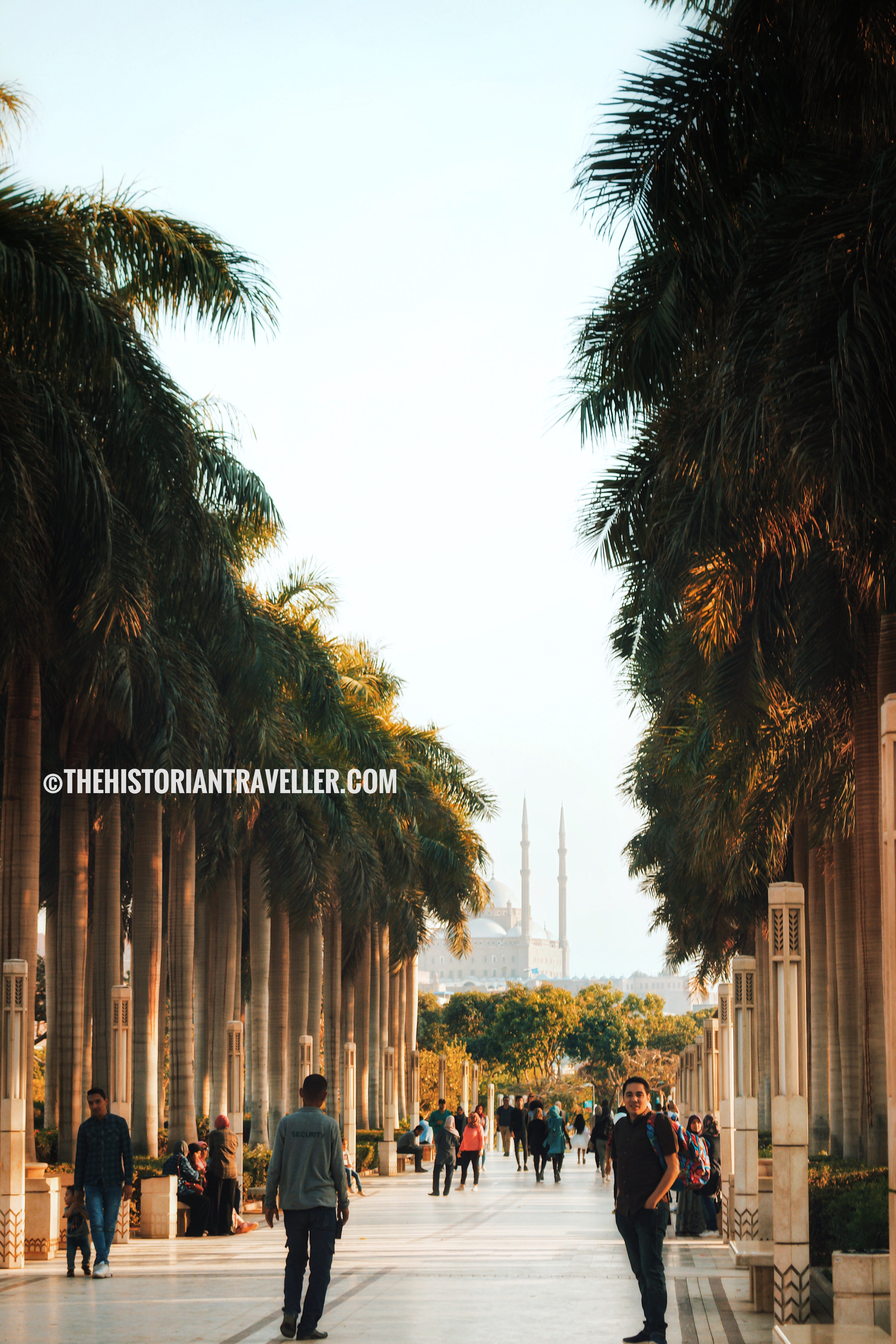
After a day walking around with only a short stop for lunch, visiting the Al-Azhar Park as a last stop on our Islamic Cairo walking tour was the perfect conclusion of our itinerary! We decided to go a sunset time because the park is situated in a very high point and offers a spectacular view of the city of Cairo.
The uncovered gem of Cairo
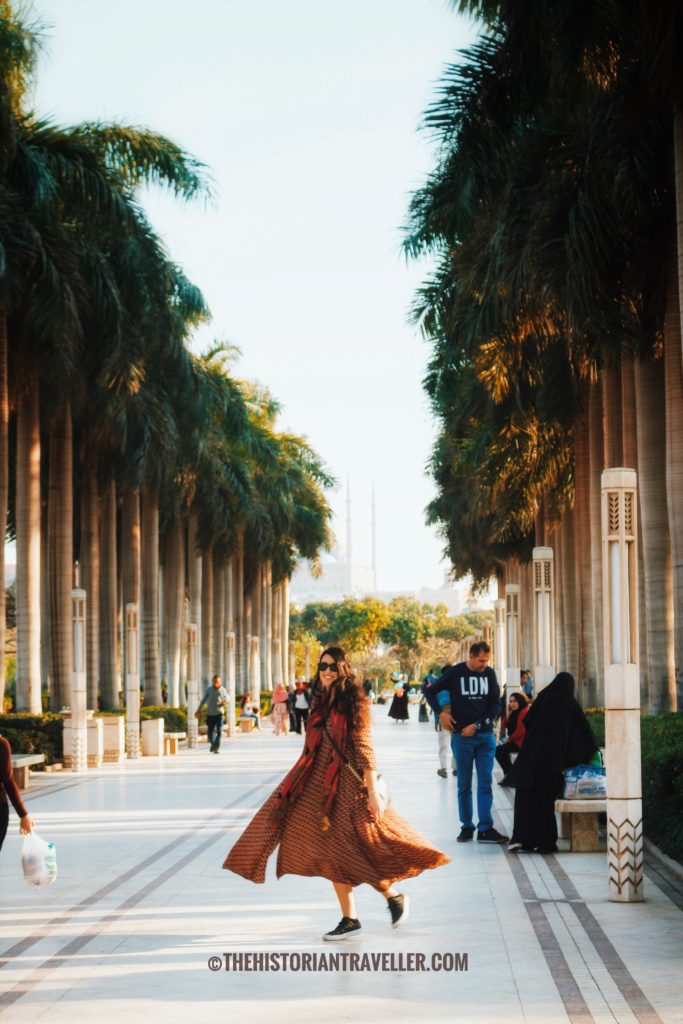
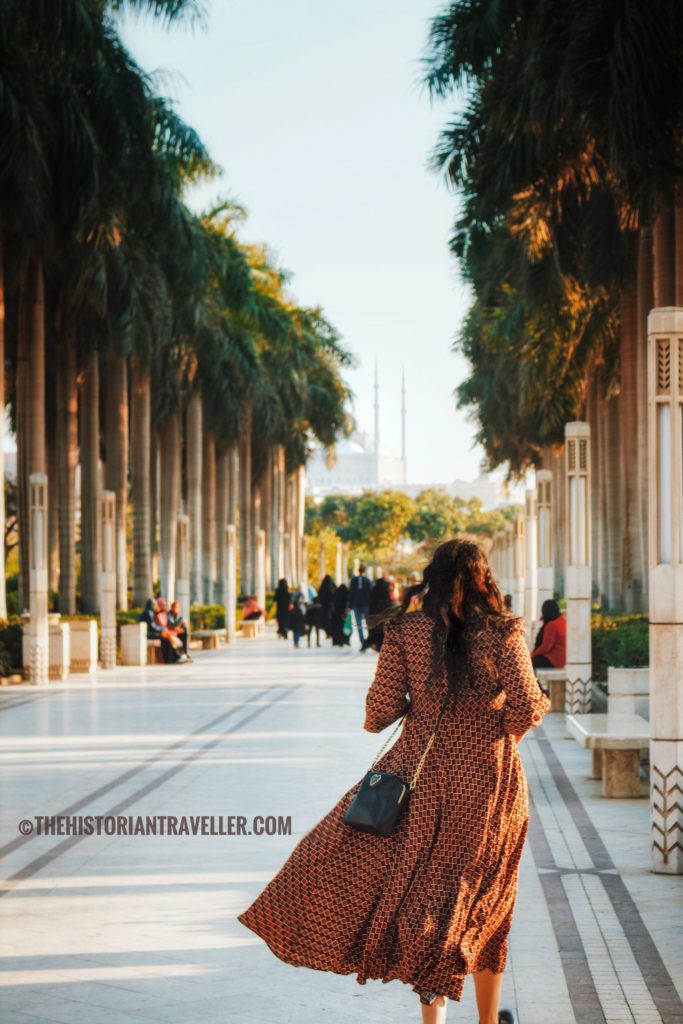
Al-Azhar Park opened just in 2005 after a massive renovation project funded by the generous donation of Aga Khan IV. In fact, before the spectacular renovation, this area amounted rubbish for more than 500 years. As suspected, inestimable treasures were buried and forgot under piles of trash for hundreds of years. When there, you need just a look to the park surroundings and the rest of Cairo to understand the immense challenge for the realisation of this project and how precious it is for a city like Cairo.
During the excavation of the soil (that in part is still ongoing), a well-preserved 12th century wall belt emerged from the underground. This was part of the Ayyubid wall built in 1176 by Salah al-Din. The wall is now restored and part of the park boundaries. Another treasure emerging from the excavations was the 15th-century Tarabay al-Sherif complex that lies on the southern side of Azhar Park just outside the wall. This dates back to 1503 and belonged to Tarabay al-Sherif, a former slave of Mamluk Sultan Qaytbay who after being set free was appointed as Amir.
Things to do at Al-Azhar Park
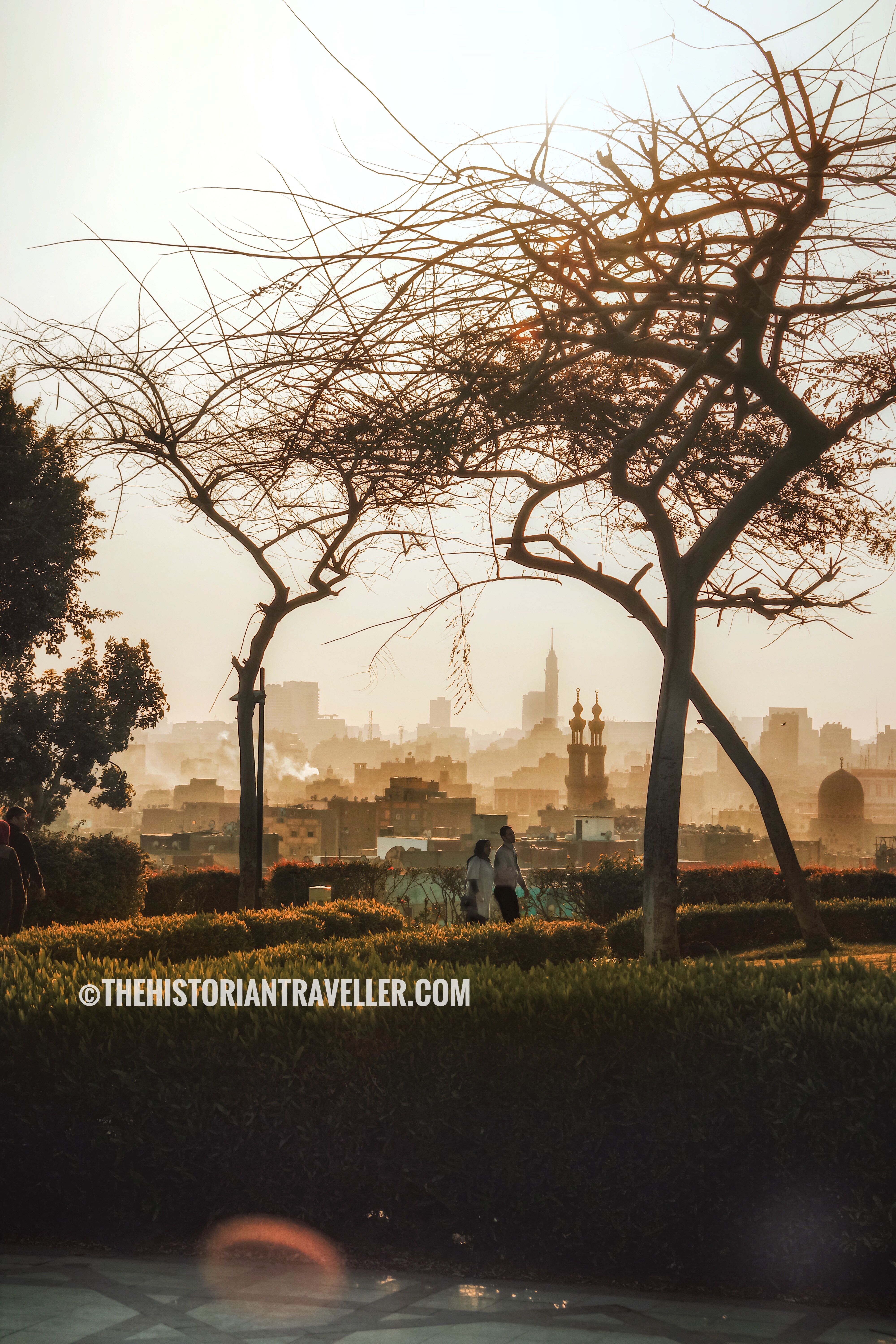
Al-Azhar park is the perfect place for a relaxing walk away from the chaotic central Cairo. In fact, the park offers many things to do. This includes historical sites, observation points and several restaurants. For this blog, I’ve collected below the most interesting things to see and do at the park.
- Visit the historic Al-Darb al-Ahmar area that is located within and outside the park.
- Visit the Mosque of Aslam al-Silahdar (1344-45 AD) and the Mosque of Qijmas al-Ishaqi (1480 – 81 AD)
- Walk in the historic Ayyubid Wall
- Visit the medieval Towers
- Watch the sunset and Cariro skyline from the highest point of the park (near the Citadel restaurant)
- Dine at the restaurant The Citadel
Where to Eat in Islamic Cairo
Lunch at Al-Hussein Square
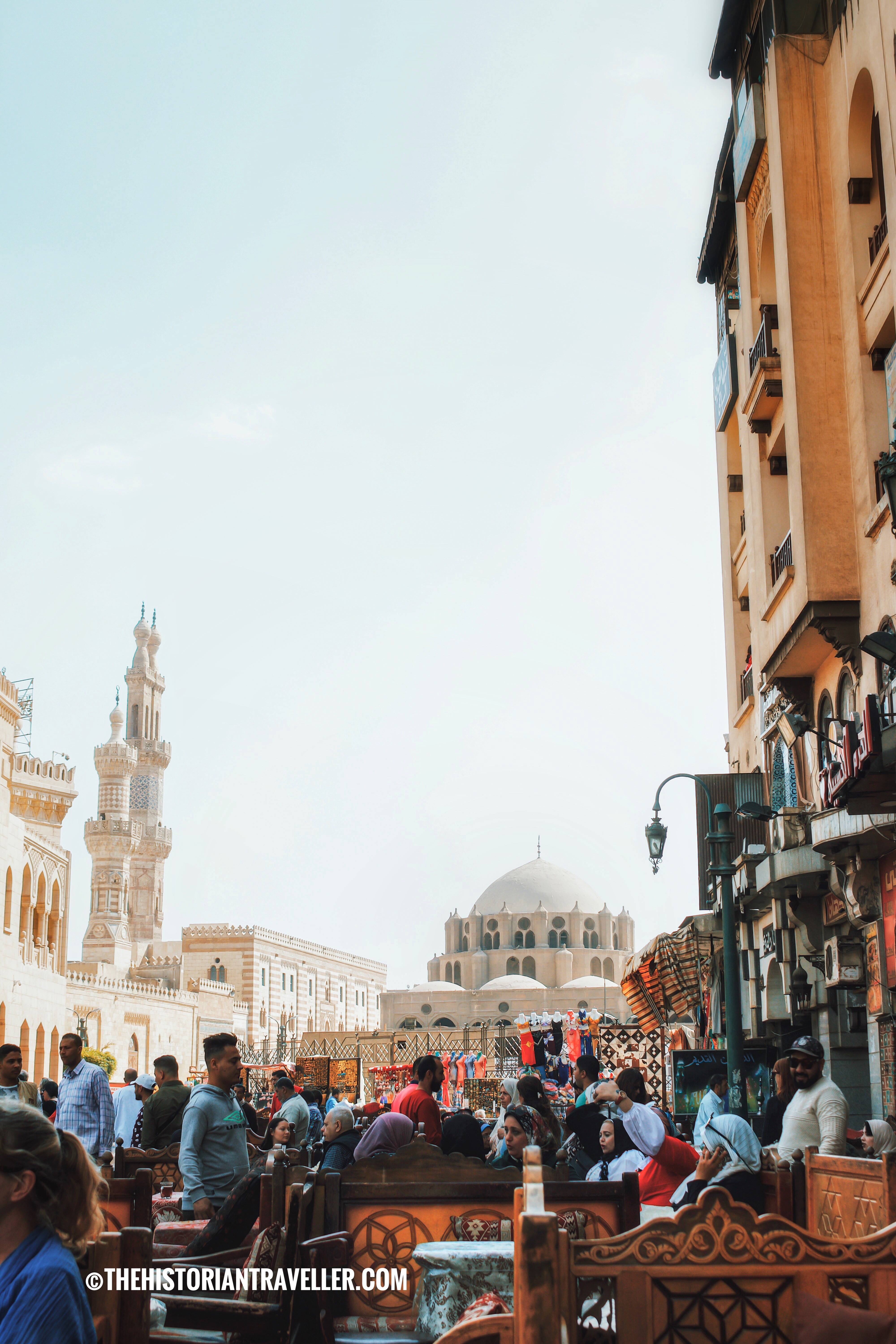
If you are hanging around the area of Khan-el-Khalili the best area where to have lunch is El-Hussein Square, where the famous mosque of Midan Hussein is located (letter E on the map). Beware that access to this mosque is forbidden to non-Muslim people, so we had to admire it only from the outside. However, one of the things I liked more of El-Hussein Square is that you have plenty of choice in terms of restaurants offering traditional Egyptian food! In fact, tables are disposed on one side of the main square and you can just pick one place and sit!
Most places have also an inside restaurant, if you don’t want to eat in the square. I wanted to get the full Egyptian experience, so we sit outside. However, the meal we had in El-Hussein Square was one of the favourite meals in the whole 20 days we stayed in Egypt! In fact, I still dream of that incredibly savoury Falafel sandwich! Unfortunately, I don’t remember the name of the restaurant because it was in Arabic, but I can give you some clues to find it!
How to find the amazing falafel restaurant
Coming from the Midan Hussein Mosque, you will find the restaurants on your right side. Walk until you find a restaurant called “Aiwlad Eyd”, the place where we had lunch is the next one (see the picture below from Google for reference and the sign beyond the picture with my husband Alessio).

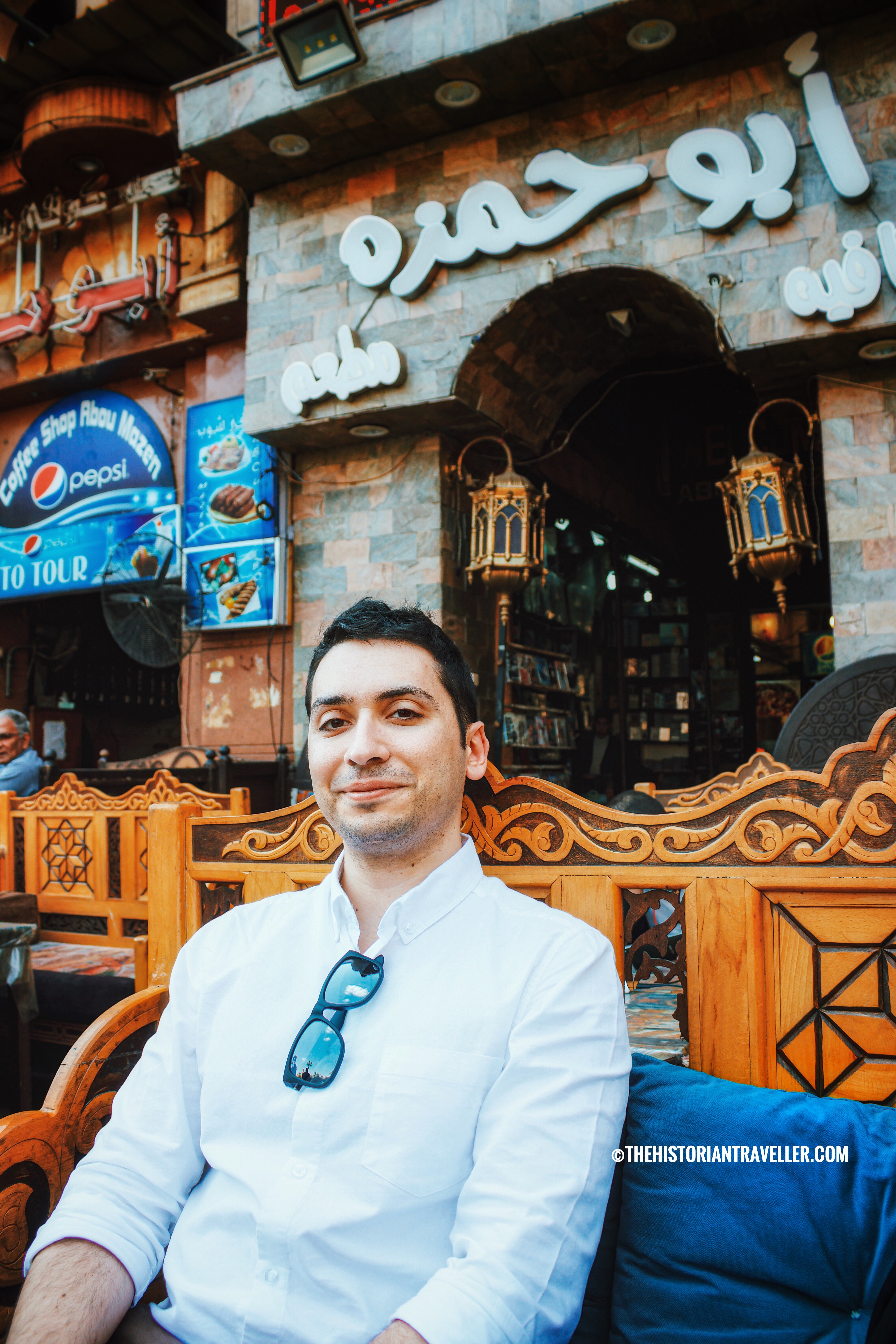
Moreover, this restaurant is also very cheap! We eat a table full of dishes (photo below), plus drinks and we paid around (150 LE (including tip) that is about £7.5)!
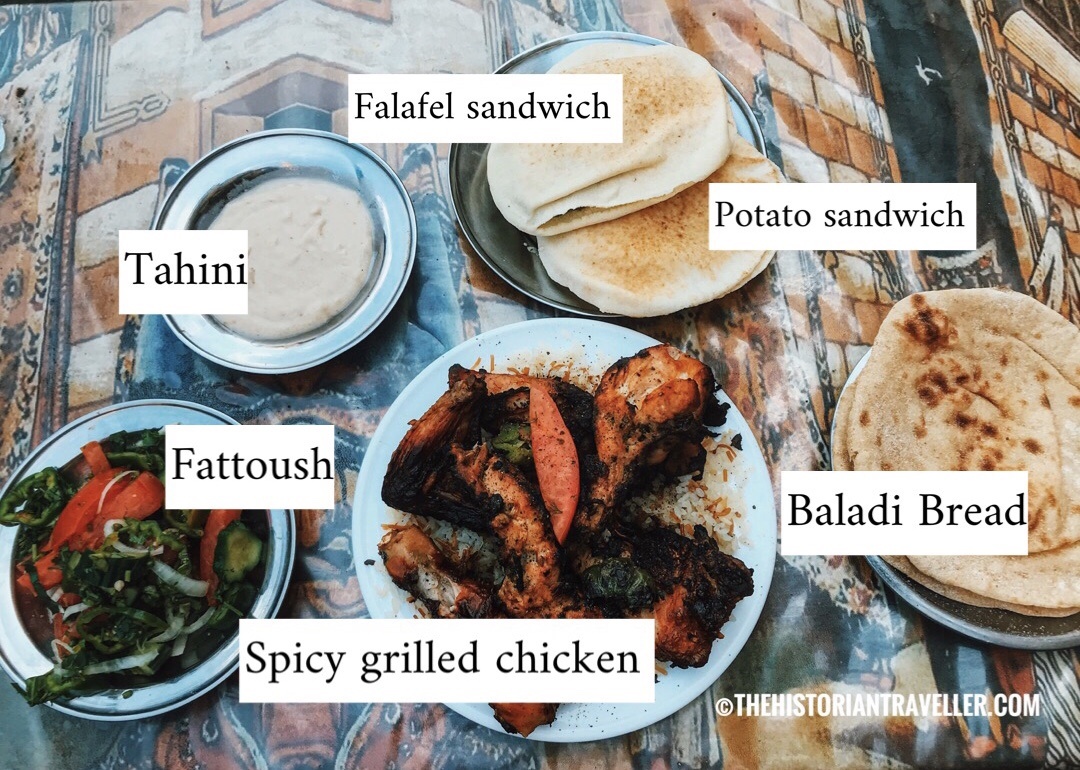
Aperitif at The Citadel View – Al Azhar Park
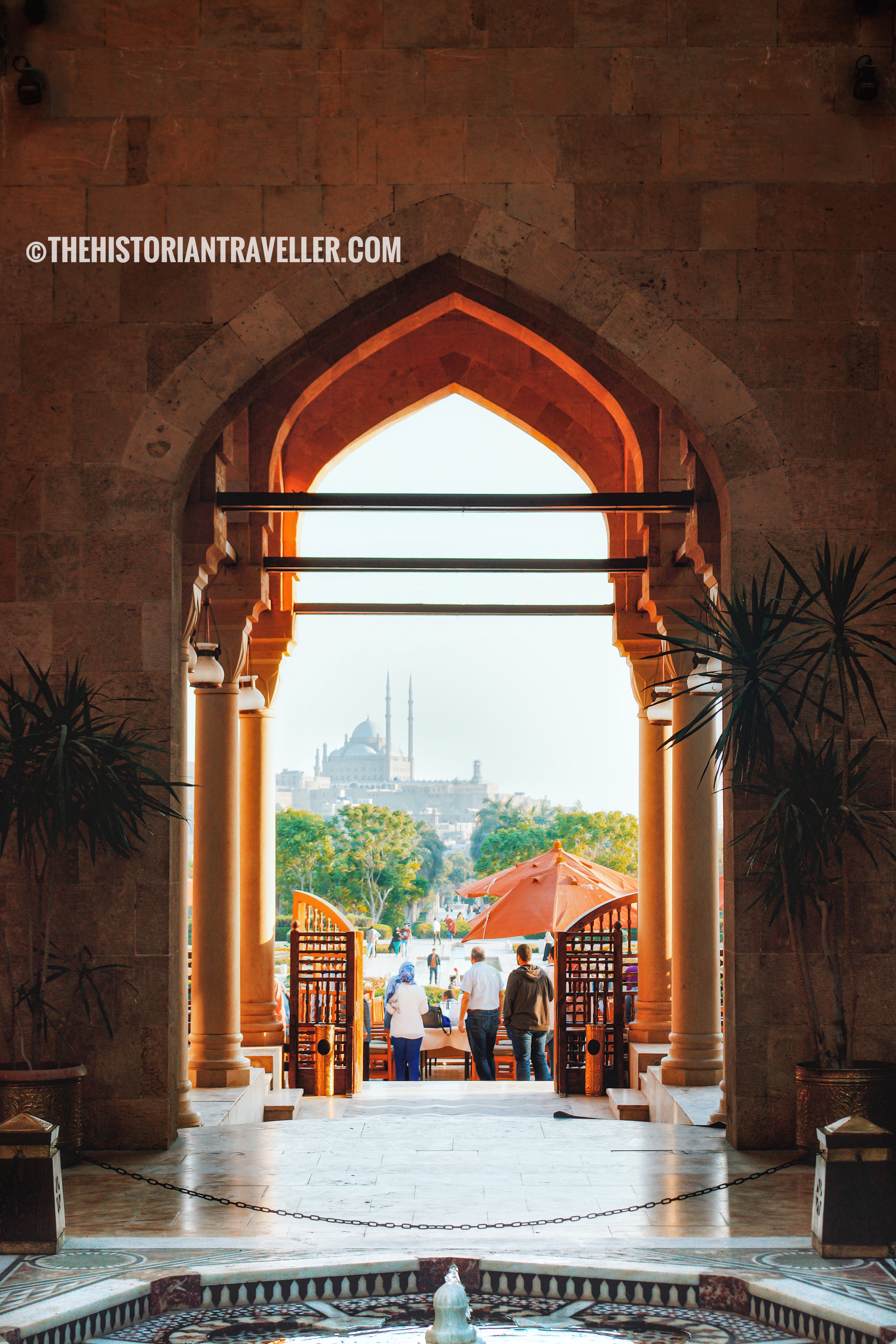
Want to make your visit at Al-Azhar even more special? Have a drink/aperitif at The Citadel View Alain Le Notre – Restaurant. That day, after the lunch in El-Hussain Square, we were quite full to have another full meal. Therefore, we decided to seat in the beautiful terrace of Citadel View Alain Le Notre to take just drink with a dessert and enjoy the sun going down from one of the most beautiful places in Cairo.
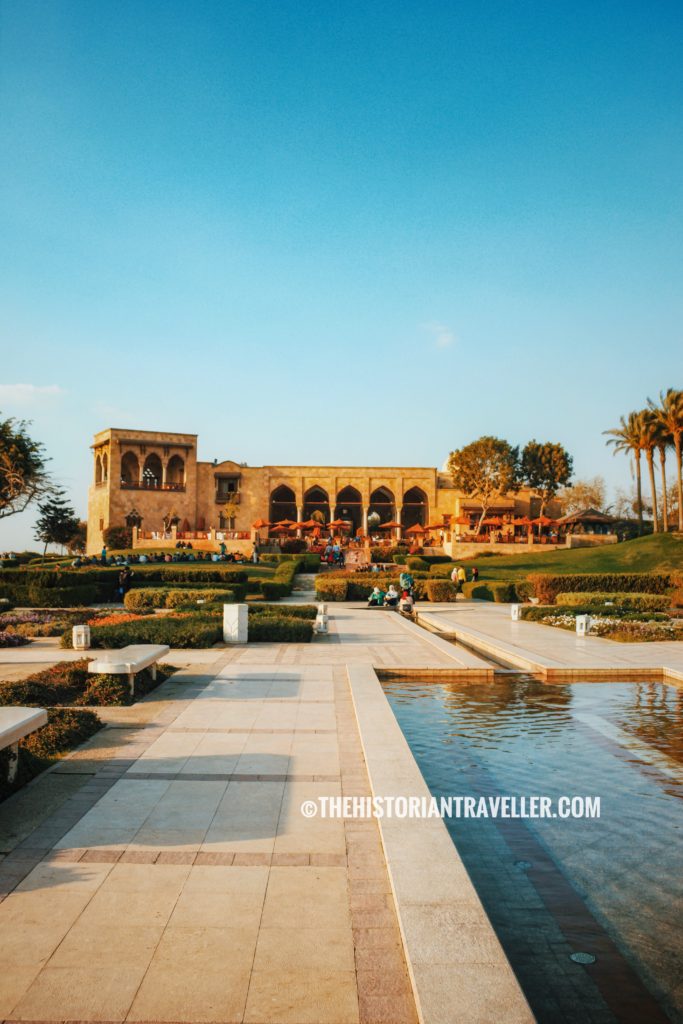
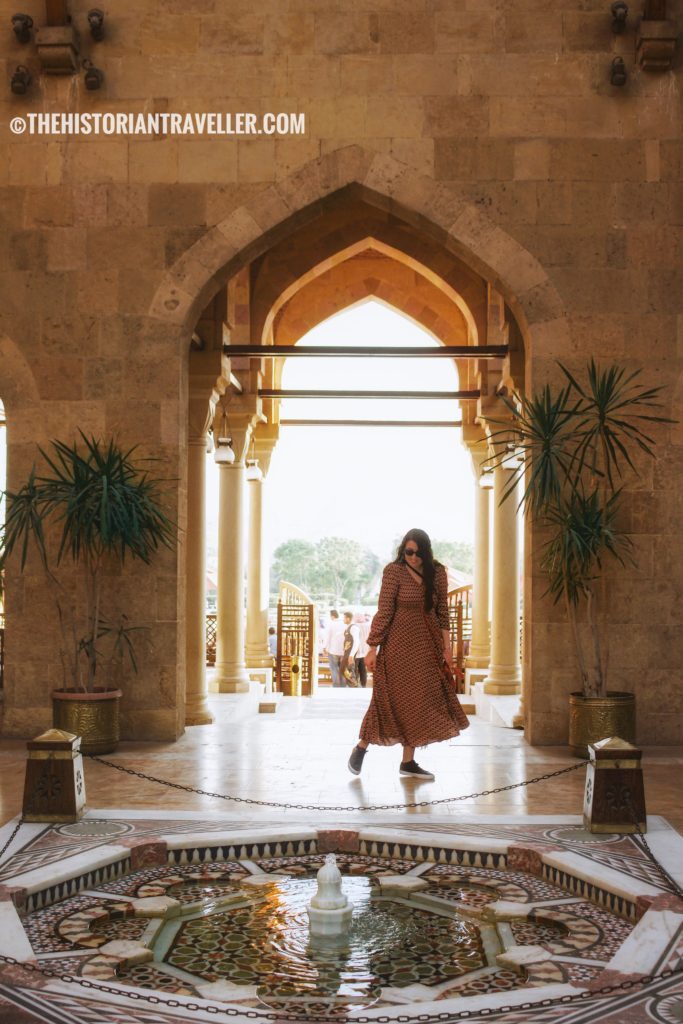
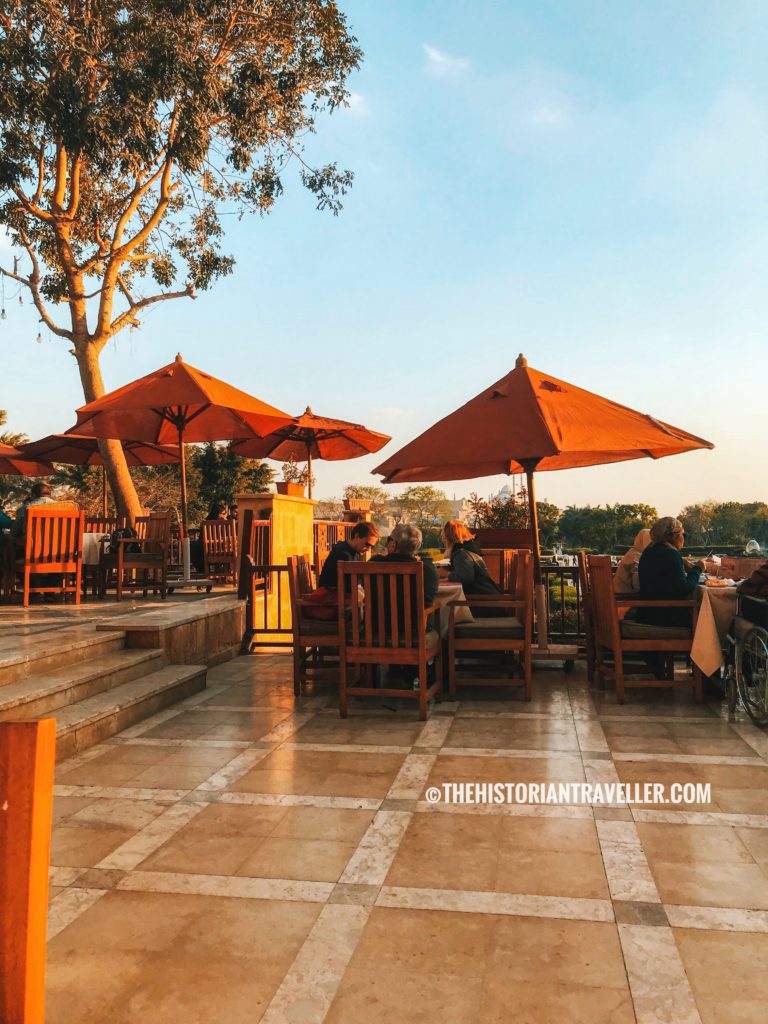
Prices are a little higher compared to most restaurants in Cairo. Considering we paid the same price of the lunch for two orange juices and two desserts. However, the place is spectacular and everything was delicious! The bad part was that the service was super slow (so slow that to apologies they offered us also some mint tea) and they mistaken my dessert! In fact, I ordered a Kunafa with Nutella but they brought me one with cream! However, we waited more than one hour and we were so tired that we decided to keep the cream one (it was delicious anyway)
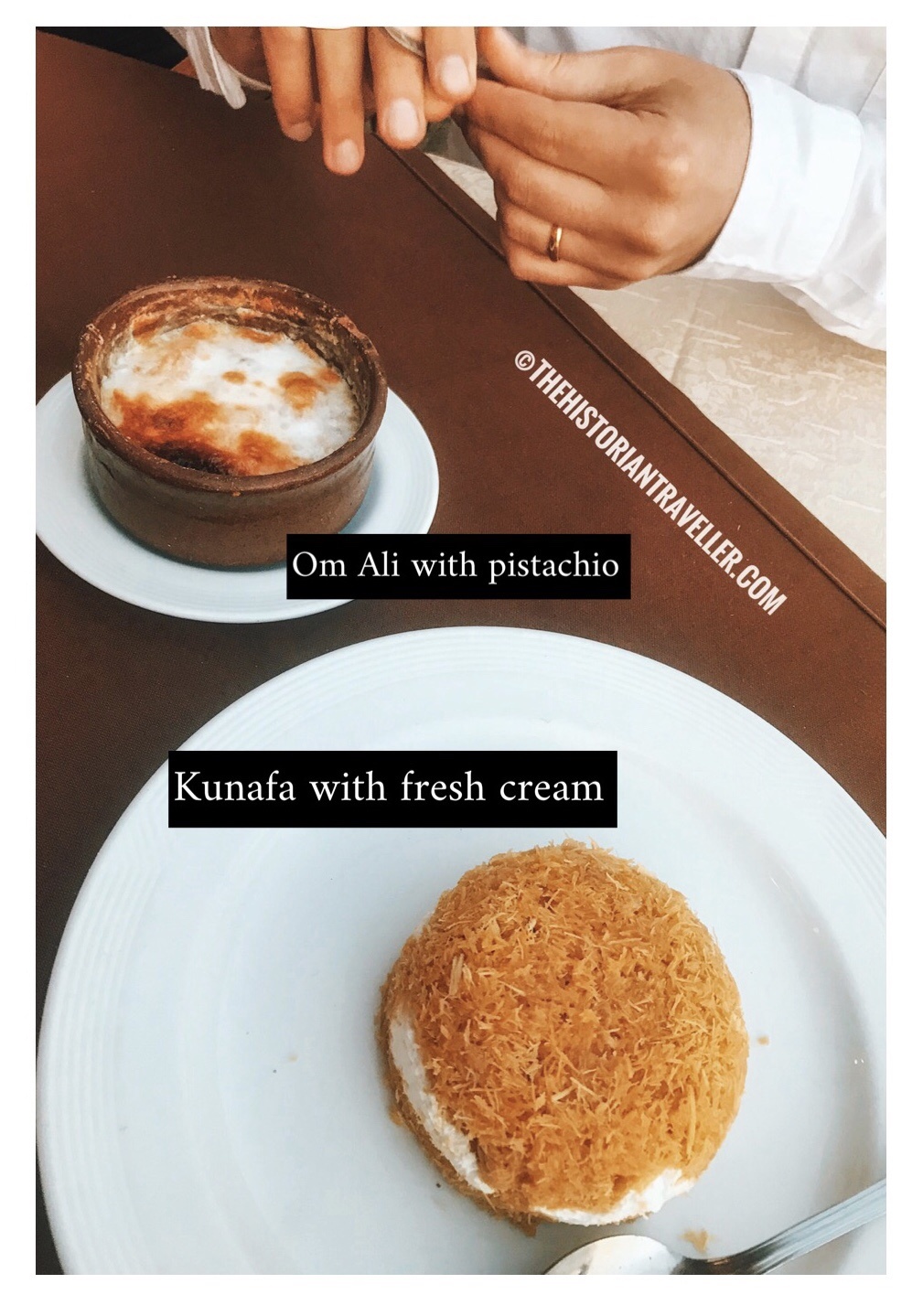
Little Note: we visited the two places below on our second round in Cairo a couple of days after the walking tour in Islamic Cairo. In fact, we planned the Egyptian Museum and other places on separate days. However, I think is better for you to have an overview of different places, so you can choose according to your preferences.
Pizza at Al Vivo Restaurant – The Nile Ritz-Carlton
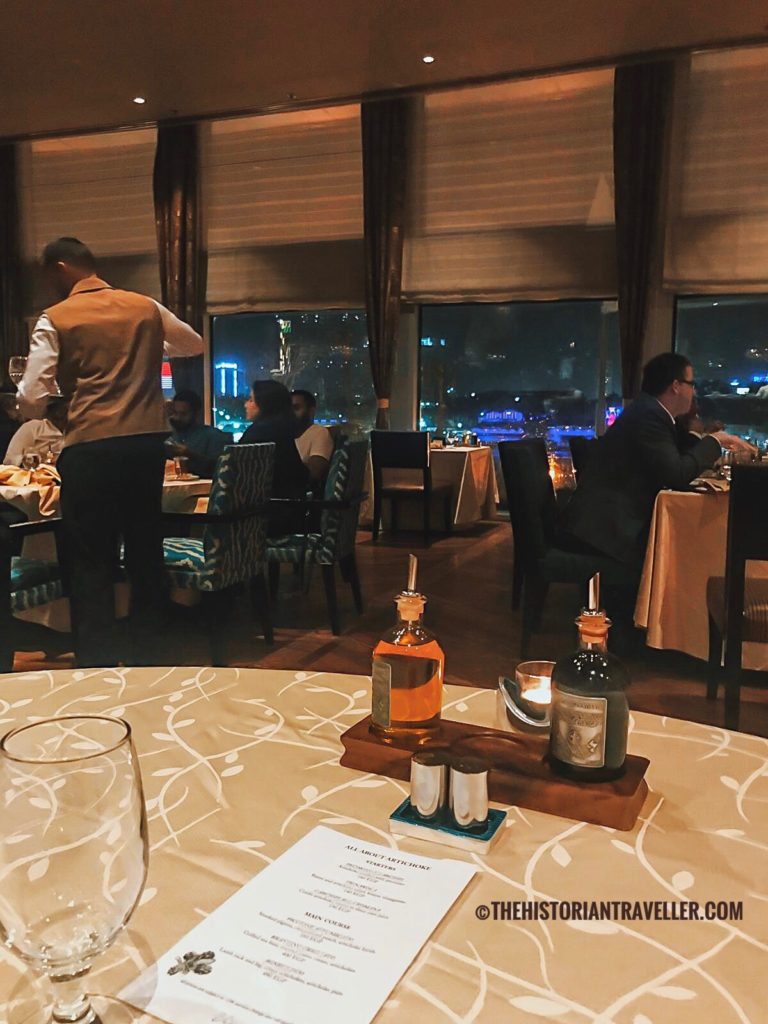
As I said in one of my previous posts, me and my husband we have this tradition of trying pizza in places outside Italy! As Italians, we know perfectly that pizza outside Italy is a culinary suicide, but we like to compare the countries and see who does it better! Of course, Egypt couldn’t be skipped and this time we choose the famous Italian restaurant at The Nile Ritz-Carlton, Vivo Restaurant.
Vivo Restaurant is located at the n°10 on TripAdvisor list of restaurants among 4,227 other places to dine in Cairo. This is a very prestigious position considering it’s a foreign cuisine in the Middle East.
A relaxed dinner
In other words, we enjoyed very much our dinner at Vivo restaurant and the pizza was quite good. In fact, we really liked the free appetisers and the classy atmosphere. Moreover, the view of the Nile from this place is fantastic! In the future, we would definitely return to try main courses like pasta, which looked delicious.
Unfortunately, except the one above, I did not shoot any picture that night because I wanted just to enjoy the moment. In fact, we went at Vivo on our second round in Cairo, after the stay in the White Desert, and that night I was quite tired and wanted just to relax. Sorry!
Tips
We did not book in advance. However, I imagine that if you want a table in a specific position (e.g. near the window on the Nile) you should book before. In fact, the restaurant was pretty full when we arrived. Moreover, if you are not guest at the Nile Ritz-Carlton, you have to pass through the external security system where a guardian will scan your bags and yourself.
Dessert with the Egyptian Museum view – La Poire Cafe
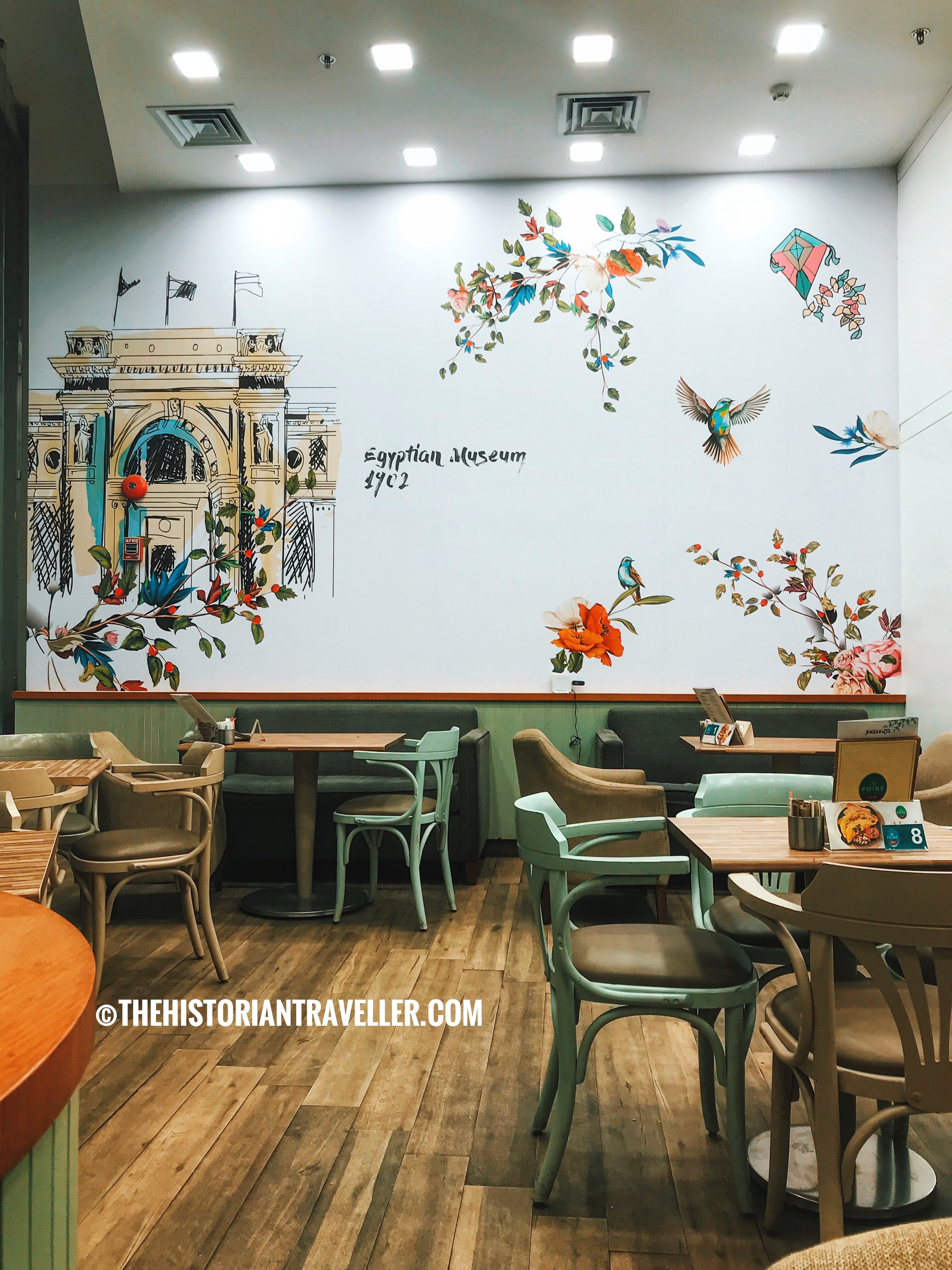
If you want to enjoy a nice breakfast or a delicious late night dessert, La Poire is the place for you! In effect, I immediately noticed this place while passing from the Egyptian Museum and I wanted to try it!

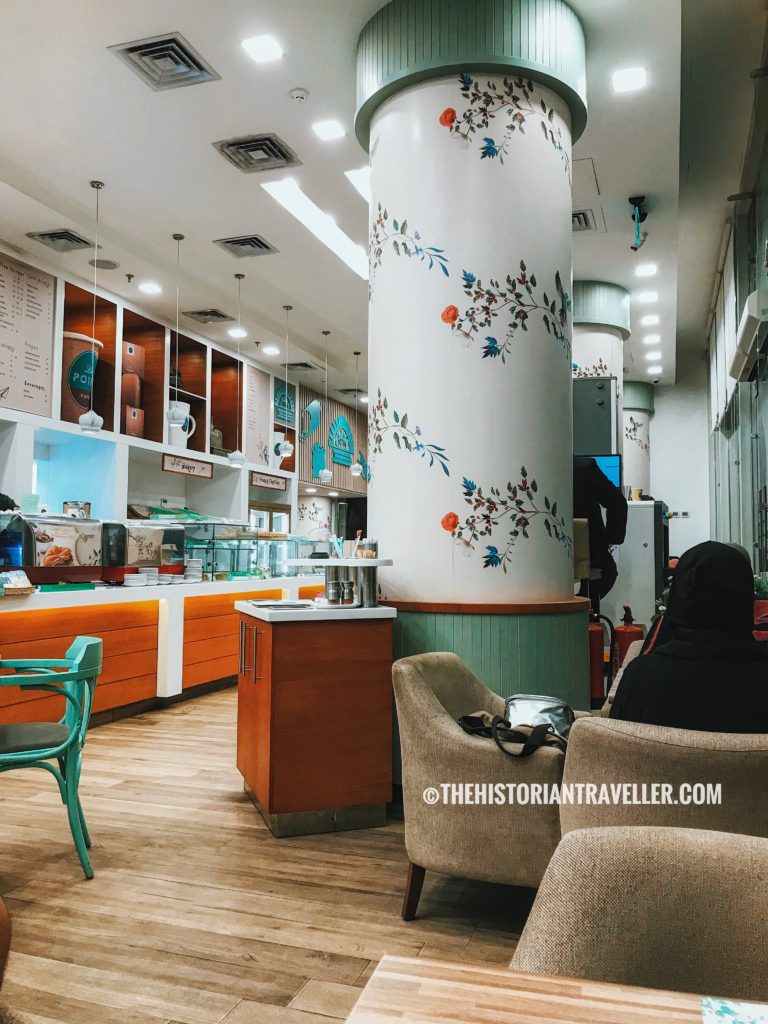
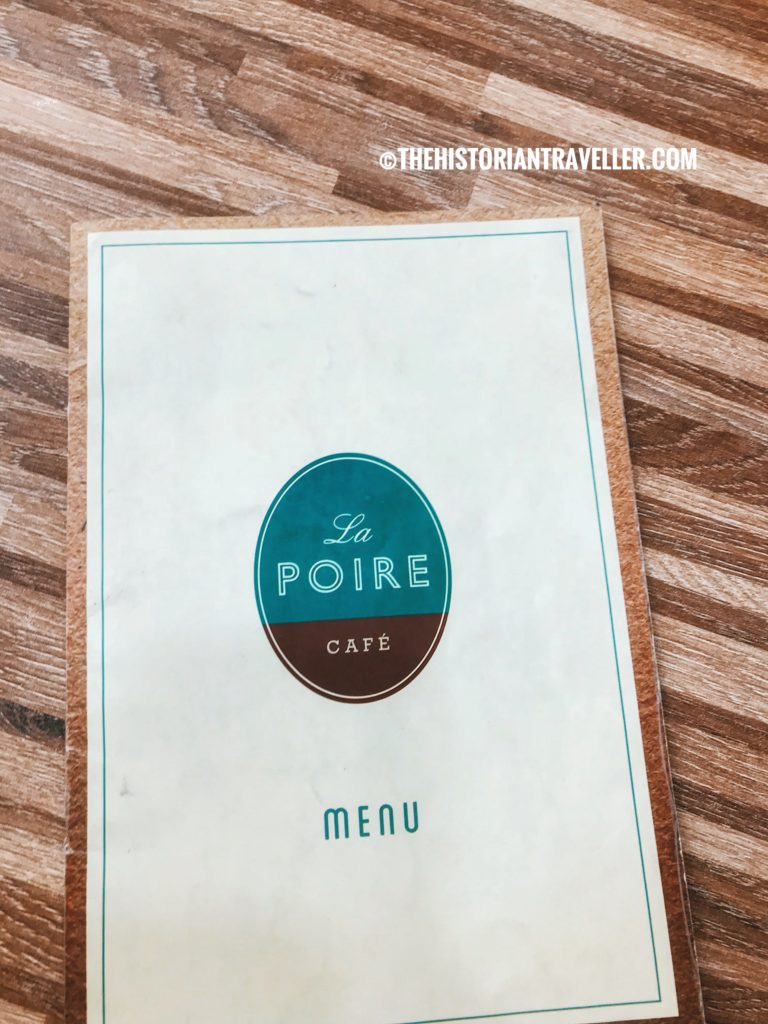
Best choice! I really loved our brownie with ice cream and it was also quite cheap! The place is exactly in the opposite side of the Egyptian Museum at 94 Makram Ebaid St. Beside Beano’s Cafe and it’s open until late night.
La Poire Patisserie is a famous chain in Egypt since 1975. In fact, they specialises in chocolate desserts, cake, croissants and a special dessert called ” La Poirette cake”. Moreover, in 1994, this Patisserie opened also a “cafe” chain that is located also in Alexandria and other important Cairo suburbs. We liked very much the quiet environment and the freshness of the ingredient. In addition, the cafe is served also by external security (with body scans).
Conclusions
In conclusion, that’s all for this Islamic Cairo walking tour! I hope you enjoyed the reading and had some useful tips to plan your Cairo adventure! As always, if you have any question, don’t hesitate to ask!
Laura
Plan your trip to Egypt


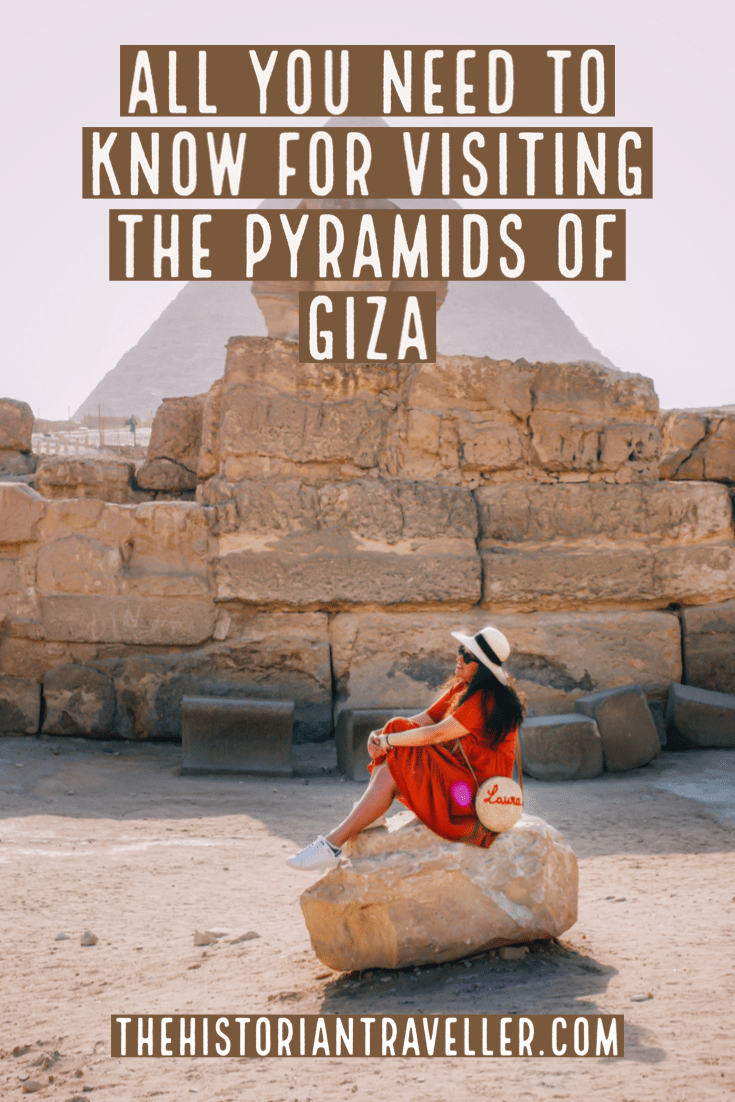
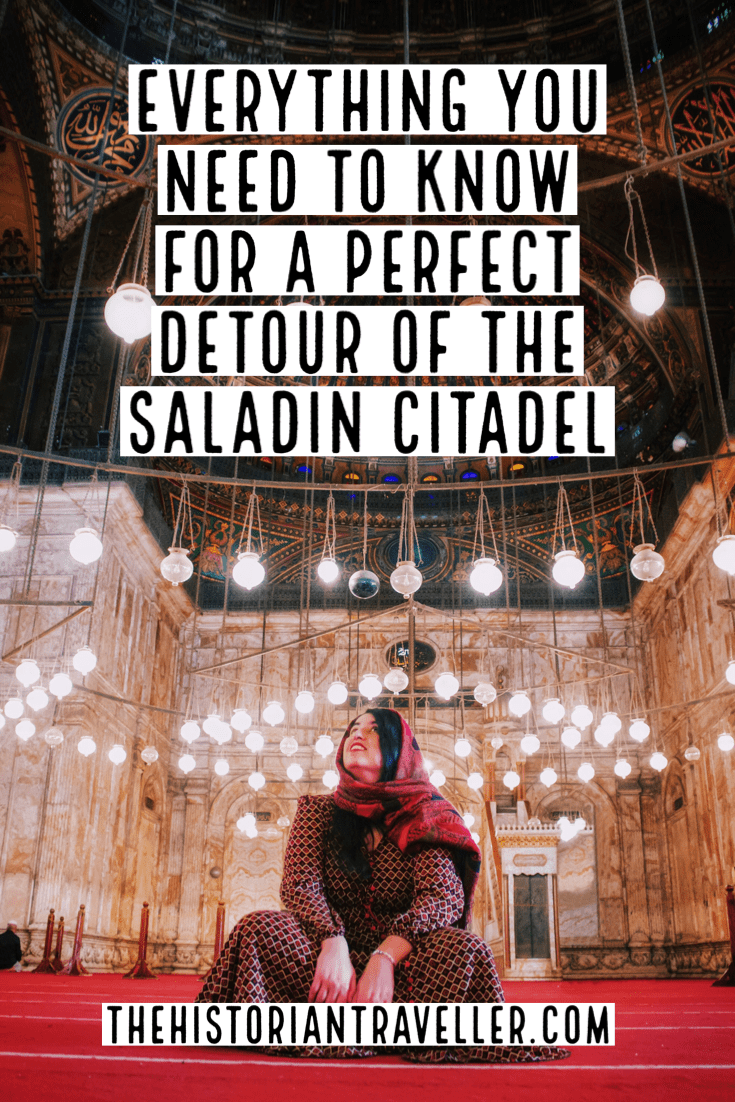
Liked this blog? Pin it for later!
